Matthew Houde's Blog
November 21, 2025
Treetopia Zipline Tour: High-Adrenaline Adventure in Monteverde
Two Weeks in Costa Rica |
Looking for a zipline tour that will have you soaring above the cloud forest? Treetopia Park in Monteverde is one of our favorite zipline experiences in Costa Rica. This is a high-adrenaline tour but still safety-focused. In this post, we’ll let you know what to expect and give tips if you’re traveling with kids.
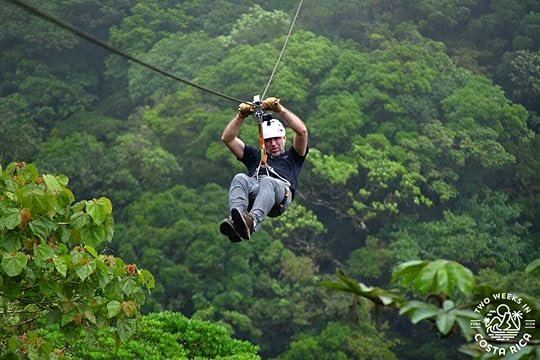
Treetopia (formerly Sky Adventures Monteverde) is located in Monteverde, a popular destination known for its misty cloud forest. The facility is about 2.5 hours from both San Jose Airport (SJO) and Guanacaste Airport (LIR) in Liberia.
Treetopia Park is about 20 minutes outside downtown Santa Elena on the way to the Santa Elena Cloud Forest Reserve. Once you get out of the main area of town, the road turns to dirt in some places, but you don’t need a 4×4 vehicle.
Tip: A four-wheel drive is recommended in general for Monteverde, but not absolutely necessary depending on which direction you’re coming from and the time of year (rainy vs. dry season). Our post Driving to Monteverde: Best Routes and Conditions has more information.
A few miles past Treetopia, you’ll find Selvatura, another popular adventure park offering ziplines, hanging bridges, and wildlife exhibits to see butterflies, sloths, and reptiles and amphibians.
About Treetopia’s Tours and FacilityTreetopia is best known for its hanging bridges (Sky Walk) that take you through the lush cloud forest and its zipline tour (called Sky Trek). They also have an aerial tram (Tree Tram), which is part of the zipline tour.
If you don’t want to zipline, you can also just do the tram tour alone to get some nice views of the cloud forest from high up.
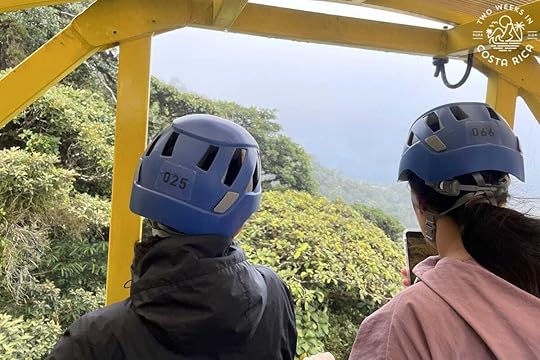 Views from the tram
Views from the tramTreetopia is an adventure park complete with a full-service restaurant and gift shop. Although it is touristy, the facility is very nice and convenient. You can do multiple activities in one day and grab lunch or a snack if you want.
Zipline Tour (Sky Trek)Getting Started First ZiplineThe zipline tour starts with a short 459 foot (140 meter) cable that goes right by the main building/restaurant. We had some friends watching our kids, and they were able to see us do it. The idea of this short line is to ease you into the experience.
Tram RideThe first cable brings you to the open-air tram, which is just a short walk away.
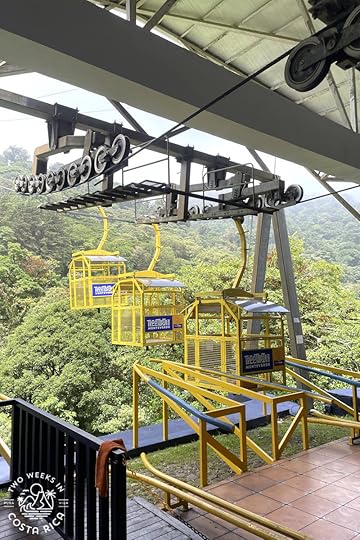 Trams
TramsThe relaxing 20-minute tram ride takes you high up the mountain. As you ascend, you’ll notice the temperature drops significantly. This is the cloud forest’s cool climate at work. Be sure to wear pants, a long-sleeved shirt, and lightweight jacket so that you’re not cold during the tour.
Once at the top, you’ll be at the highest point on the property, 5,700 feet (1,737 meters) above sea level.
Depending on the day, it might be sunny, windy with clouds blowing by quickly, or rainy, or all three things at once. This unpredictable, misty environment is what makes the cloud forest special and keeps it nice and green.
If you have clear skies, you may be able to see Arenal Volcano (in La Fortuna) in the distance.
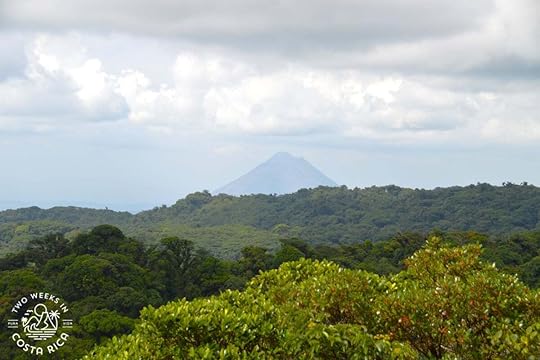 View of Arenal Volcano from the tram on a clear day
View of Arenal Volcano from the tram on a clear dayThere are some bathrooms when you get off the tram to use before you start ziplining. This area has a small snack bar, though there wasn’t much time to grab anything when we did the tour.
The CourseTreetopia’s zipline tour is about 2 hours long. On the multi-mountain circuit, you’ll zigzag back and forth over canyons above the treeline and get some amazing panoramic views of the lush cloud forest below.
The course has 7 cables. Some reach up to 328 feet (100 meters) high and 2,460 feet (805 meters) long. The total ride distance is an impressive 1.9 miles (3 km).
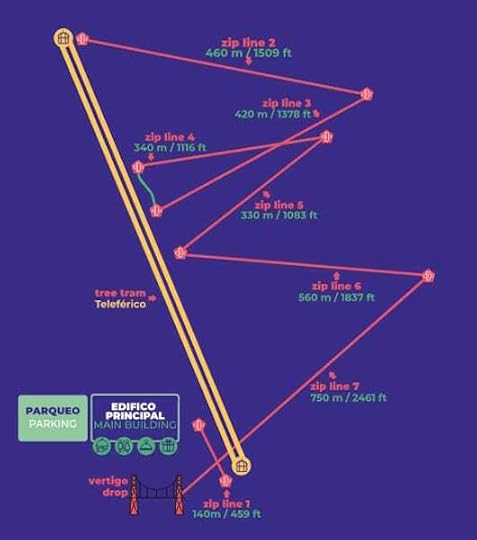 Map of the courseGuides
Map of the courseGuidesThe company’s guides are fun, safe, and good at making people feel comfortable. At the beginning of the tour, they teach you how to use the equipment. They demonstrate how to position yourself in the harness (just lean back) and hold the pulley that hangs down from the cable as you glide. They also explain what to do if you need to brake.
 Our guide showing us how to use the equipment
Our guide showing us how to use the equipment

For braking, the guide at the end of the line will motion their arm if you need to brake as you’re coming in. You brake by moving the metal pulley handle back and forth. This isn’t necessary on some of the cables because they’re so long, but heavier people may need to brake on some lines.
We personally loved the guides on the tour we did. They were very friendly and fun, but also professional, always making sure our equipment looked good and we were comfortable before sending us off.
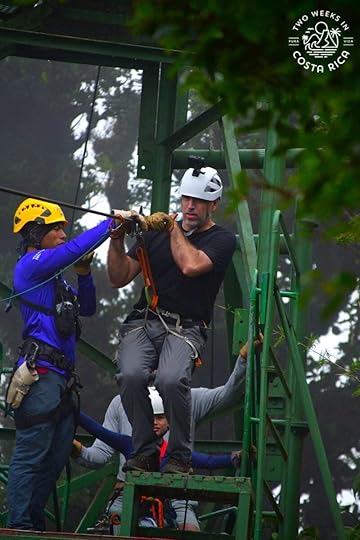 One of the guides helping Matt get into positionWhat Makes Treetopia Special
One of the guides helping Matt get into positionWhat Makes Treetopia SpecialThis is one of the few zipline tours in Costa Rica where you don’t need to touch the cable. Instead of holding the cable with a gloved hand to brake, you can easily hold the metal pulley. This makes it a great option for kids since they can just lean back and go. See our section on Ziplining with Children, below, for more information.
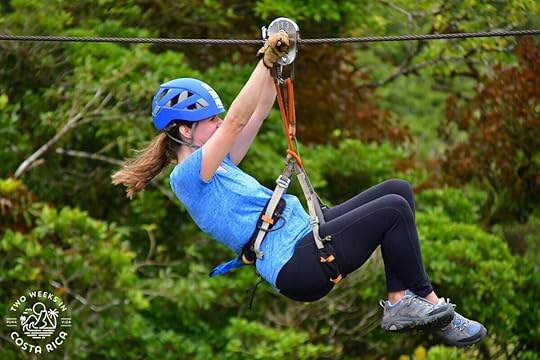 Jenn showing how to hold the pulley
Jenn showing how to hold the pulleyNo hiking is required between platforms. There is one very short walk between a couple of platforms, but that’s it. The platforms themselves are sturdy metal structures with plenty of space.
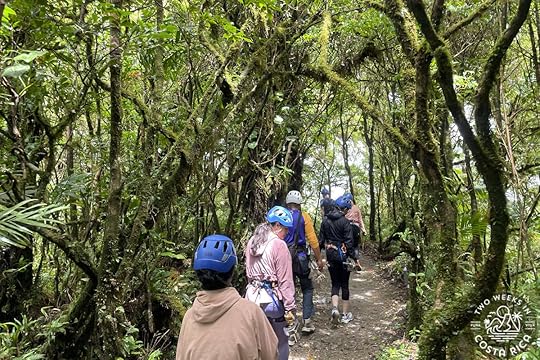 Short walk between two of the platformsCable-by-Cable BreakdownCable 1
Short walk between two of the platformsCable-by-Cable BreakdownCable 1This is the short cable we described above that gets you to the tram.
Cable 2Cable 2 is one of the longest lines at 1,509 feet (460 meters). You’ll have plenty of time to take in the cloud forest views from this one.
 Zipping through the cloudsCable 3 – Tandem Line
Zipping through the cloudsCable 3 – Tandem LineThis 1,378-foot (420-meter) line is one of two tandem lines where you need to go with another person to make it all the way across.
If you’re traveling solo or in an odd group of people (a family of 3 or 5, for example), the guides will pair you with someone else from the tour. Honestly, this did seem a little awkward for the couple of people who had to do this since the person in the back needs to wrap their legs around the person in the front. Not ideal, if you can avoid it!
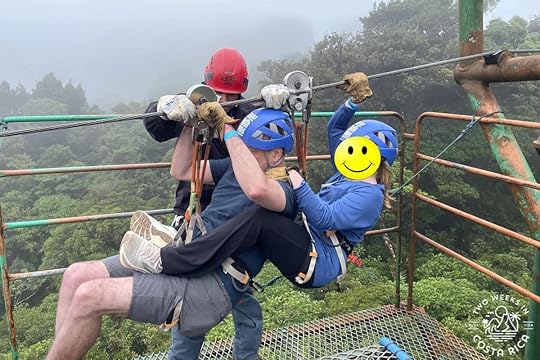 Another family tandem zipliningCable 4
Another family tandem zipliningCable 4There’s a short walk through the cloud forest after Cable 3 to get to Cable 4, which is 1,116 feet (340 meters).
Cable 5This is another fairly long cable at 1,083 feet (330 meters).
Cable 6 – Tandem LineThe second tandem line measures a long 1,837 feet (560 meters).
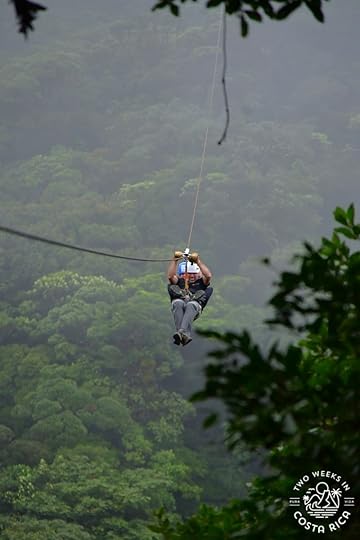 Us doing one of the tandem ziplinesCable 7
Us doing one of the tandem ziplinesCable 7Your final zipline is 2,461 feet (750 meters), giving you one last big rush.
Vertigo DropAfter the final cable, you have the option of doing the Vertigo Drop, a 79-foot (24-meter) controlled free fall.
Matt opted to do this on our visit and said it was quite a thrill! You’re attached to a harness and free fall backwards off a platform. The name “Vertigo” must have to do with how this can make you feel a little disoriented. Other people we talked to who also did it said it made them feel similarly but they did enjoy it.
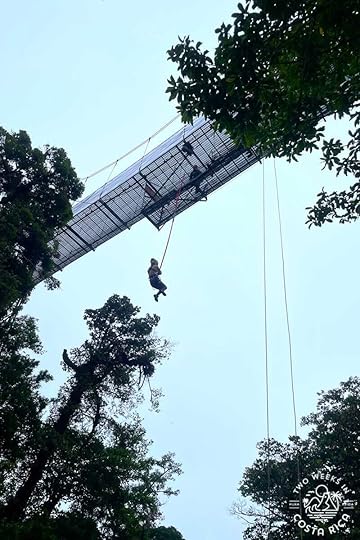 Vertigo DropZiplining with Children
Vertigo DropZiplining with ChildrenTreetopia’s zipline tour has a minimum age of 5 years old. There is no minimum height.
Young children may go alone on the ziplines if the lead guide deems it appropriate. It will depend on the child’s weight and specific weather conditions at the time. Otherwise, it will be at the guide’s discretion to determine who will accompany the child on the cable.
When we did the tour, our kids weren’t with us, but there was another family with a father and 7-year-old boy. The child didn’t weigh enough to go by himself but was able to ride tandem with his dad (not a guide). Treetopia doesn’t guarantee this, as it depends on each participant’s weight, the weather, etc., but it is a possibility. If your child can’t zipline alone, you’ll be able to talk to the lead guide about who they will ride with. They do their best to make everyone feel comfortable and have fun.
 Walking on the bridge at the end of the tourPlanning Your Treetopia Zipline TourBooking Your Tour
Walking on the bridge at the end of the tourPlanning Your Treetopia Zipline TourBooking Your TourAdvanced reservations are required. Be sure to book through our travel agency to take advantage of our discounts. Just request a booking through the links below and we will confirm the reservation and send you a payment link. Read our reviews.
CostSave $10+ per adult and $9+ per child on your Treetopia zipline tour! Our special discount includes no booking fees. The savings are automatically included in the rates below.
 Treetopia Combo Tour (Ziplining + Hanging Bridges) – From Monteverde Price: From: $111.00 +VATSelect options
Treetopia Combo Tour (Ziplining + Hanging Bridges) – From Monteverde Price: From: $111.00 +VATSelect options
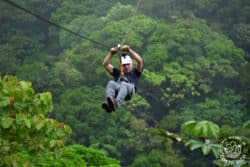 Treetopia Zipline Tour – From MonteverdeRated 5.00 out of 5 Price: From: $85.00 +VATSelect options
Treetopia Zipline Tour – From MonteverdeRated 5.00 out of 5 Price: From: $85.00 +VATSelect options2025 Rates: $85 per person for adults; $67 per person for children ages 5-17. All rates are plus 13% tax.
2026 Rates (Starting December 15, 2025): $95 per person for adults; $75 per person for children ages 5-17. All rates are plus 13% tax.
Offered: On the hour from 7:00 a.m. to 3:00 p.m.
Duration: About 2 hours
Includes: Bilingual guides and all necessary equipment. Transportation is available for an additional $12 per person. If you’ll have a rental car, we recommend driving to Treetopia yourself (no 4×4 required).
Maximum Weight: 300 pounds (136 kg). Harness measurements: waist up to 46 inches.
Minimum Age: 5 years old. There is no minimum height requirement.
What to Bring and WearClosed-toe shoes, pants, long-sleeved shirt, light rain jacket, insect repellent, sunscreen, water, and strap for prescription glasses.
PhotosThere is a professional photographer at a few of the lines. They take photos and videos, which you can purchase for $15 per person at the end of the tour. We bought them and thought they were pretty good.
Go Pros and Action CamsGoPros can be rented for around $40. Or you can bring your own. They have the mounts for the helmets. If you plan on setting up your own camera on the helmet, we’d recommend talking to the staff when you first get there so that they can accommodate you.
 Our action cam setupConclusion
Our action cam setupConclusionTreetopia’s zipline tour is one of our favorite ziplines in Costa Rica. We love how the lines go so fast and also that it’s an easy tour. You don’t have to hand brake like you do at many other zipline tours in Costa Rica. Whether you’re looking for an adrenaline rush or are bringing your family for their first zipline experience, Treetopia is a great option. We highly recommend it if you’re visiting Monteverde.
Have a question about Treetopia’s zipline tour or have you done it? Leave a comment below.Looking for more information to plan your trip? Check out these posts:Monteverde: A Forest in the Clouds – Our full destination guide gives more options for more can’t-miss activities in Monteverde.
Monteverde Tours: View all the activities we book on our Monteverde Tours page, including cloud forest nature hikes and coffee tours.
Hanging Bridges and Ziplining: Not sure about zip lining in Monteverde? Our Hanging Bridges and Ziplining articles cover other great options for zipline tours all around the country.
Things to Do: View all 150+ activities that we cover on this website. Waterfalls, wildlife tours, national parks, chocolate tours, river floats, and lots more.
The post Treetopia Zipline Tour: High-Adrenaline Adventure in Monteverde appeared first on Two Weeks in Costa Rica.
October 17, 2025
Hotel Los Lagos Review: A Budget-Friendly Hot Springs Resort in La Fortuna
Two Weeks in Costa Rica |
Our family recently stayed at Hotel Los Lagos, one of the most affordable (and popular) hot springs resorts in La Fortuna, Costa Rica. In this post, we’ll give an overview of what the property is like and share our experience. We’ll cover everything from the thermal pools and rooms to the resort’s amenities and nearby attractions.
Note: This is an unbiased review based on our personal experience. We paid for our stay and received no compensation. We share our honest opinions to help you plan your trip. Read our hotel reviews for properties all around Costa Rica.
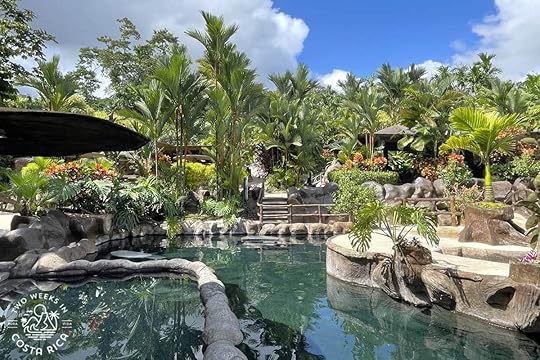
Hotel Los Lagos is a very popular, family-friendly hotel and one of the most budget-friendly hot springs resorts in La Fortuna. While it may not be the fanciest accommodations in the area, many people love it for its value, spacious grounds, and variety of amenities.
It’s a large property set on 1,050 acres (425 hectares) with a true resort feel. About 100 rooms are spread out in small buildings around the property.
The hotel is located right off the main road to Lake Arenal, a short drive from downtown La Fortuna. The property extends far back towards Arenal Volcano. A road inside the resort leads to a lovely volcano viewpoint and emerald-colored lake, for which the hotel was named.
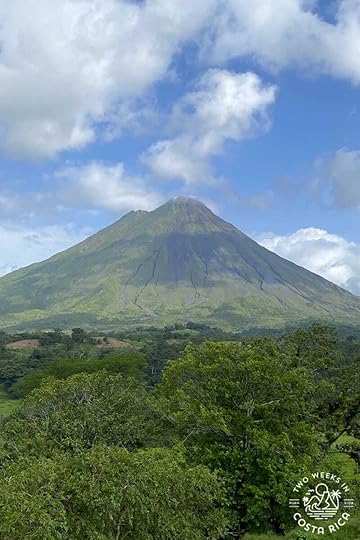 The iconic Arenal Volcano
The iconic Arenal VolcanoHotel Los Lagos has gorgeous hot springs onsite. The eight thermal pools are different temperatures and are surrounded by lush gardens. It also has a couple of cool water pools and waterslides that are a hit with kids.
Rooms are large and comfortable with an authentic Costa Rican feel—think native woods and traditional styling rather than modern luxury.
There’s a pool bar/restaurant and full restaurant open three meals a day, plus a spa and several onsite activities.
Location and Volcano ViewsHotel Los Lagos is in a good location, only about 10 minutes from downtown La Fortuna where you’ll find most of the area’s restaurants and stores. It’s right off the main road (Route 142) but set back. We didn’t notice much road noise during our stay.
The foothills of Arenal Volcano back the property. On a clear day, you can see the entire volcano. Arenal is a towering, cone-shaped volcano that is the focal point of this area.
During our visit to La Fortuna in mid-December (when we were comparing several hot springs resorts), clouds obscured most of Arenal Volcano. We could only see the base, which is typical for this time of year. Our When to Visit section, below, gives more on what to expect for weather.
 Our view of the base of Arenal Volcano
Our view of the base of Arenal VolcanoLos Lagos Hotel is about 2.5 hours from Costa Rica’s largest international airport in San Jose (SJO) and 2.5 hours from Guanacaste Airport in Liberia (LIR).
Tip: Since La Fortuna is more spread out, it’s nice to have a rental car to get to restaurants in town and area attractions. If you decide to rent a car, be sure to check out our discount to save 10% through one of the most reputable rental companies in Costa Rica.
Customer Service and Check-inWe arrived shortly after check-in time and there was a long line with people checking into the hotel and for day passes. Los Lagos allows people to visit their hot springs for the day, so some locals were arriving to get their wristbands.
Although the check-in process took a while, it was smooth and easy. The friendly employee provided us with a helpful property map so that we could get our bearings. We were each given wristbands.
Front desk staff is available 24 hours a day during high season (December-April, July, August 1-5, December 17-31, and Easter Week). During low season, hours are 6:00 a.m. to 10:00 p.m.
Property Set UpThe Reception, main restaurant, hot springs, and pools are centrally located on the lower end of the property near where you enter.
IMPORTANT: When reserving a room, keep in mind its location, especially if you won’t have a rental car. While some rooms are only a short walk to Reception (1-2 minutes), others are higher up on the property and best accessed by driving.
If you’re looking at the property map, the rooms in the 100s are the closest to Reception and the pools. Most of these are Standard rooms (101-117 and 403-414), but there are also Superior rooms in this area (118-159).
Our Superior room (in the 200s) was in the back of the property, about a two-minute drive from the main facilities. It would have been a very long walk. We were happy to have our car.
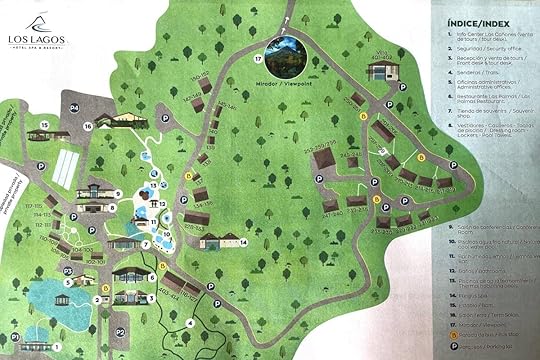 Property Map
Property MapNote that if you won’t have a rental car, the hotel has a free shuttle that you can call for pickup.
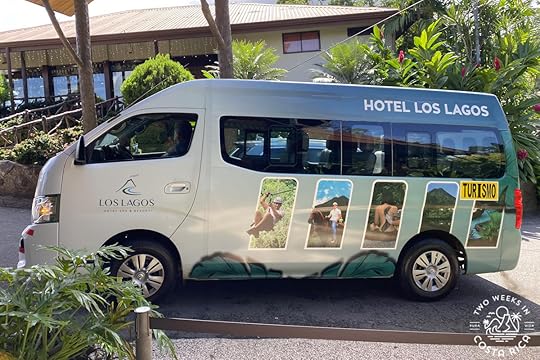 Free shuttle to get around the propertyRoom Options at Los Lagos Hotel, Spa and Resort
Free shuttle to get around the propertyRoom Options at Los Lagos Hotel, Spa and ResortMany of the rooms at Los Lagos are dated and could use some renovations, but they’re very comfortable. We liked that it felt like a traditional Costa Rican hotel. The accommodations have a good setup for families in particular.
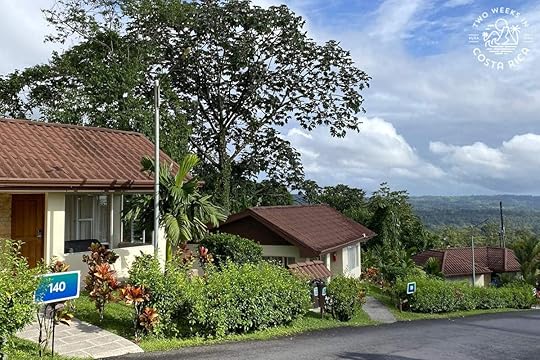 Some of the Superior rooms closer to Reception
Some of the Superior rooms closer to ReceptionHere are the room types:
Standard RoomsBasic but comfortable rooms with 2 double beds and views of the volcano or gardens. Each room is 40 square meters (430 square feet) and holds up to 4 people.
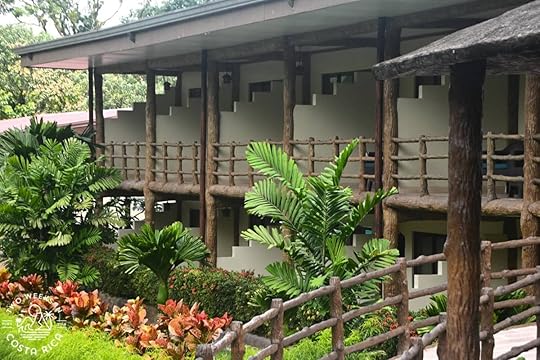 Standard rooms near the ReceptionSuperior Rooms
Standard rooms near the ReceptionSuperior RoomsLarger rooms at 60 square meters (645 square feet) with 2 queen beds and 2 optional trundle beds to accommodate up to 6 people.
Our family stayed in a Superior room and couldn’t believe how big it was. The trundle beds were perfect with our two young kids. They slid out from under the main beds and could be pushed back when not in use.
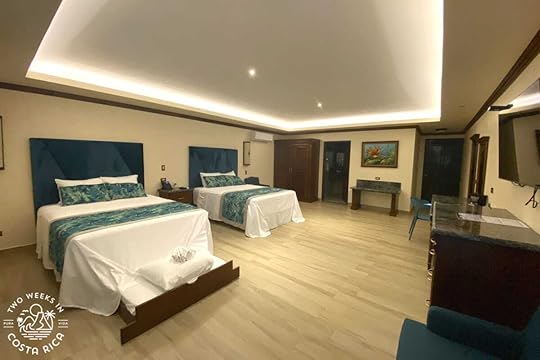 Our Superior room
Our Superior roomEach Superior room has a terrace or balcony. Our room had a large terrace with a comfortable two-person sofa where we enjoyed relaxing.
Tree HouseThe tree house is the newest room type; they only have one. It’s the most upscale option, with a more modern feel. The tree house comes with 1 king bed and is good for couples.
It has some unique features like a private thermal pool with whirlpool beds, balcony with jungle views, outdoor shower, and electric fireplace. It’s located high up on the property so has nice views.
VillaThere’s only one villa/house on the property. It’s designed for groups of up to 9 people. One area has 2 double beds, a living room with a sofa bed, and bathroom. A connecting door leads to another area that has two levels. On the lower level is a fully equipped kitchen, and the top floor has a king bed and 2 trundle beds along with a bathroom.
Room AmenitiesAll rooms have air-conditioning, a hairdryer, phone, complimentary Wi-Fi, coffee maker, mini-fridge, cable TV, and a safe deposit box.
Room PricesLos Lagos is a mid-range hotel in La Fortuna. Prices vary seasonally, with the rainy season (May to mid-November) offering the best rates.
In general, you can expect to pay $150-230 per night for a Standard Room (double occupancy) and $185-245 per night for a Superior Room (double occupancy). The Tree House and Villa are more expensive at $330-750 per night for the Tree House, and $485-620 for the Villa. Rates are plus tax (13% in Costa Rica).
The peak season, when prices are highest, is during Christmas/New Years and Easter Week.
Check current rates and availability at Hotel Los Lagos.
Hot SpringsThe hot springs were the best part of our stay. The eight thermal pools are heated naturally by the volcano’s powerful geothermal energy.
The main pool is located near the swim-up bar and restaurant. This is where you’ll find the largest pool. It tends to be the busiest and most social spot since the bar is right there.
 The swim-up bar at night
The swim-up bar at nightSeveral smaller pools branch off at different levels going up the property. Each has a different temperature, so you can find one that’s perfect for you—some are quite hot while others are pleasantly warm.
 One of the hot springs
One of the hot springsThe landscaping all around is beautiful. Lots of thick tropical greenery creates more private, intimate spaces. Palm trees, flowering plants, and lush vegetation surround every pool, making you feel like you’re in a jungle oasis.
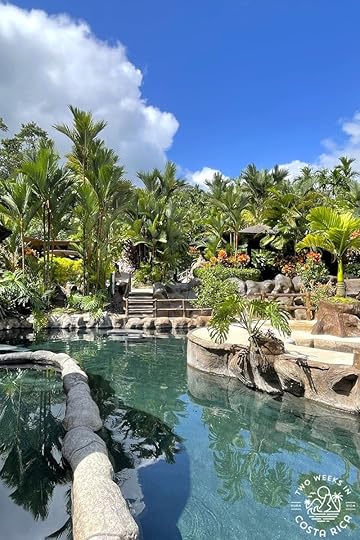 Lush palm trees and tropical gardens
Lush palm trees and tropical gardensSome pools have built-in seats with jets, which were really popular on our visit. They’re good if you’re looking for a massage-like experience. We enjoyed moving between the different pools to find our favorite temperature and set-up.
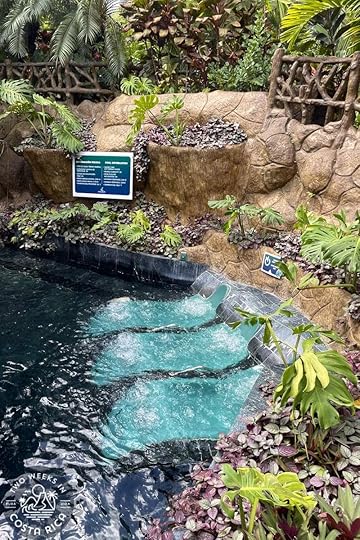 The chairs with jets
The chairs with jetsThe resort has a locker room and offers towels. You have to return them at the end of your visit or there’s a fee.
Hours: 10:00 a.m. to 10:00 p.m.
Swimming PoolThe resort also has two large cool water pools with many lounge chairs and tables spread around for relaxing. They’re next to the hot spring pools so that you can go between them if you get too hot.
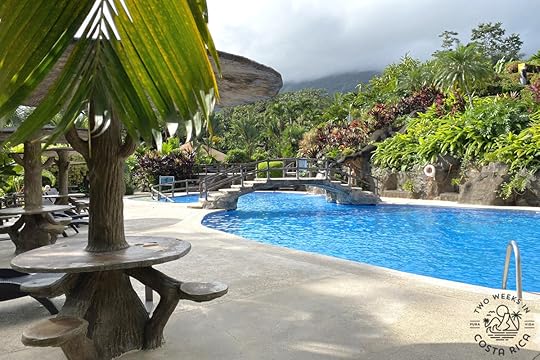 Cool water pool
Cool water poolThe pool area also has two fun waterslides that empty into the cool water pool. They’re fast so better for adults, teens, or more adventurous kids.
 One of the fun waterslides
One of the fun waterslides The waterslides empty into the cool poolsRestaurants at Los Lagos Hotel, Spa and Resort
The waterslides empty into the cool poolsRestaurants at Los Lagos Hotel, Spa and ResortThe resort has one main restaurant that is open for three meals a day and a casual restaurant with a swim-up bar at the hot springs.
Las Palmas – Main RestaurantThis restaurant serves a mix of Costa Rican and international cuisine. The menu is huge with salads and many steak, chicken, fish, and pasta dishes. There’s a kids menu with spaghetti bolognese, chicken fingers, cheeseburger, and mac and cheese. Entrees are $10-29.
We ate lunch here, and the food was fairly good. The portions were generous, and the service was friendly. However, it is a little overpriced given the quality. If you have a rental car, we highly recommend heading to one of the many great restaurant choices in town. Our La Fortuna Destination Guide has some of our favorites.
 Tuna tartar with avocado at the hotel restaurant
Tuna tartar with avocado at the hotel restaurantOne of the best parts of the restaurant is the atmosphere. It’s open-air and looks out to the gardens. We saw tons of colorful birds coming around, even trying to steal food!
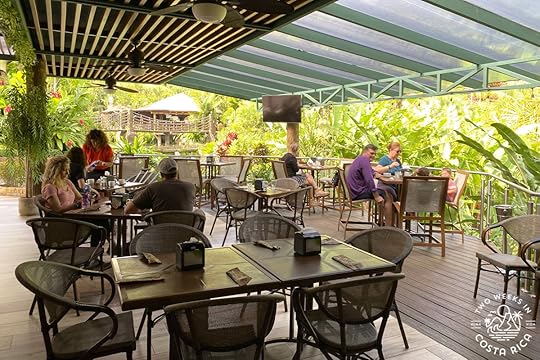 Main restaurant
Main restaurantThe atmosphere is casual and family-friendly. We appreciated the convenience of having a full restaurant onsite. It was great to be able to grab a quick lunch after doing an early-morning tour.
Food restrictions: The menu doesn’t label allergens or dietary restrictions (like nuts, dairy, gluten-free, vegetarian, vegan), though each dish is clearly described in both English and Spanish.
For vegetarians and vegans, there are few options, mostly pasta dishes.
Los Lagos also has a buffet for lunch and dinner during busier times of year.
Hours:
Breakfast: 6:30 a.m. to 10:00 a.m.Lunch: 12:00 p.m. to 3:00 p.m.Dinner: 6:00 p.m. to 9:30 p.m.Room service is available from 12:00 p.m. to 9:30 p.m.
Lemnos Wet BarThis is the pool bar restaurant at the hot springs. It has a small swim-up bar and a few tables set up right in the water where you can relax with a drink. A few more tables are on an adjacent patio.
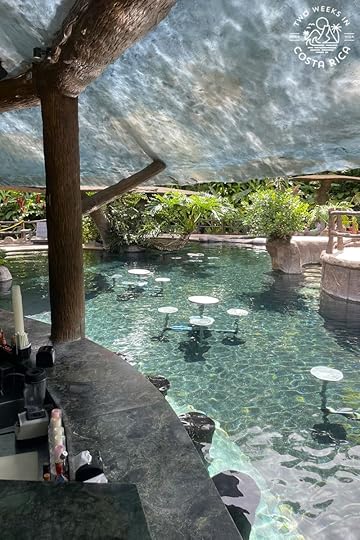 Swim-up bar
Swim-up barThe menu is small with casual food like hamburgers, pizzas, nachos, ceviche, fish tacos, and sandwiches.
There’s a huge cocktail menu with both alcoholic and nonalcoholic drinks. Several cocktails are made with Cacique guaro, a local spirit made from sugar cane.
They have their own craft beer (two types) made by a local brewery called San Roque. We tried the Summer Ale and it was good.
They also serve fresh fruit smoothies—our kids said that they were awesome.
Drink prices are very reasonable at around $4-7.
The area around the pool bar is the busiest spot at the resort. On our visit, it got crowded around 6:00 p.m.
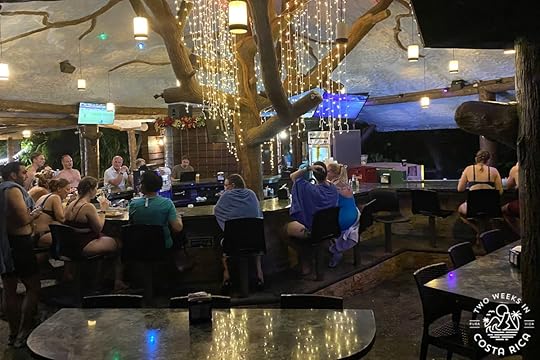 The busy bar
The busy barEverything was wonderful at the hot springs except that it took us a long time to pay our bill on one occasion because it was busy and there wasn’t much staff.
Pool Bar Restaurant Hours:
Bar: 10:00 a.m. to 10:00 p.m.Kitchen: 11:30 a.m. to 9:30 p.m.BreakfastBreakfast is included for all guests, which is a great benefit.
The hotel serves a large buffet with basic offerings. You’ll find things like traditional gallo pinto (rice and beans), scrambled eggs, bacon and sausage, hash browns, pancakes, fresh tropical fruit, muffins, pastries, toast, cheese and deli meats, and fresh juices.
Everything is standard breakfast fare, but there’s enough variety that everyone should be able to find something they like. The fruit is always fresh, and the Costa Rican coffee is good.
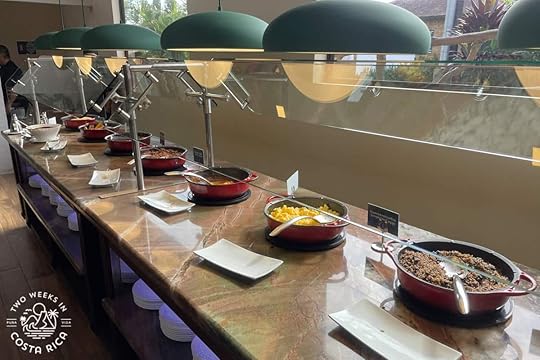 Breakfast buffet
Breakfast buffet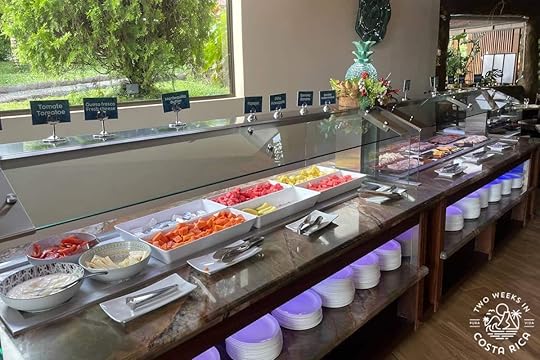 Fresh fruitSpa
Fresh fruitSpaThe resort’s Fangas Spa is nestled within the property’s lush tropical surroundings. The treatment rooms are surrounded by forest, creating a peaceful atmosphere.
The services menu is impressive. It includes therapeutic massages (around $100 for 60 minutes), body wraps and exfoliations (around $75), facials (around $40), manicures, and pedicures.
They offer local specialties like volcanic mud facials and coffee exfoliations that use Costa Rican ingredients, along with hot stone massages using volcanic rocks.
GymHotel Los Lagos does not have a gym, but if you run, you could check out the roads and trails inside the resort. Just keep in mind that the property is hilly.
Activities OnsiteThe resort offers a few activities onsite.
You can go zip lining right on the property (1.5 hour tour; $70). We saw people zipping by the restaurant during one of our meals!
Horseback riding is also available ($70; 2 hours) on an 8-kilometer (5-mile) trail.
You can also kayak on the small lake on the property.
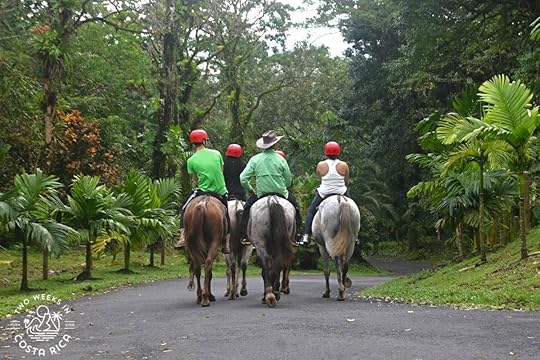 Horseback riding tourMirador/Viewpoint
Horseback riding tourMirador/ViewpointA highlight is the Mirador. This scenic viewpoint has an incredible view of Arenal Volcano and Lake Los Juncos. Los Lagos, “the Lakes,” was named after this green-colored lake. It’s worth the drive or long walk up to see it (about 2.8 km/1.7 miles from Reception).
TrailsWe didn’t have time to check them out, but the resort has a short loop of trails where you can see birds, turtles, and butterflies.
Family-Friendly AmenitiesWhile the hotel doesn’t have specific amenities for kids like a game room or playground, kids usually love the pools, waterslides, wildlife viewing, and trails. Ours did!
 An iguana we spotted near the poolWi-Fi
An iguana we spotted near the poolWi-FiThe Wi-Fi is good throughout the property, including at the hot springs.
Souvenir ShopThe large souvenir shop is right across from the restaurant. It sells clothes and Costa Rica-themed gifts like Christmas ornaments, coffee mugs, and wood carvings. It also had a good selection of Costa Rica children’s books and local wildlife guides.
The shop stocks insect repellent, sunscreen, and personal care items. Prices seemed reasonable at the gift shop. A stuffed animal we bought for our kids in town was actually less at the resort.
SustainabilityWe were impressed with the large field of solar panels on the property. This isn’t something you typically see in Costa Rica, and it shows the resort’s commitment to sustainability.
There are recycling bins near the rooms and in common areas throughout the property.
Nearby AttractionsThe resort’s location makes it convenient for exploring La Fortuna’s popular attractions:
Arenal Volcano National Park: 15-minute driveMirador El Silencio Volcano Hike: 10-minute driveArenal 1968 Trail Volcano Hike: 10-minute driveLa Fortuna Waterfall: 10-minute driveMistico Hanging Bridges: 20-minute driveSky Adventures Zip Lining and Hanging Bridges: 25-minute driveLake Arenal: 15-minute driveLa Fortuna Downtown: 10-minute driveDiscover the best activities in La Fortuna/Arenal with our post, 19 Unique Things to Do in La Fortuna.
Value for MoneyHotel Los Lagos is an excellent value, especially for families. While the rooms aren’t luxurious, they’re spacious and comfortable. The hot springs are the main draw and they’re well-maintained with beautiful landscaping. At $150-245 per night for most rooms, it’s one of the most affordable hot springs resorts in La Fortuna.
The property does allow day pass visitors, which means the pools can get crowded during peak times. However, we found that early mornings and later evenings were quieter.
If you’re looking for a budget-friendly hot springs resort with good amenities, Los Lagos is a solid choice. The large rooms, multiple pools, onsite restaurants, and activities make it convenient, especially if you’re traveling with kids.
Traveling with kids? Be sure to check out our Costa Rica with Kids page for more family travel planning resources.
 Upscale decor at the main restaurantPros and Cons of Los Lagos Hotel, Spa and ResortPros:Very affordable compared to other hot spring resorts in La FortunaAmazing volcano view from all around the property (weather permitting)Eight hot spring pools with varying temperaturesLarge, comfortable rooms that can accommodate familiesCool water pools and waterslidesFull-service spaOnsite activities like zip liningBeautiful tropical landscaping throughout the propertyGood location close to La Fortuna and area attractionsCasual, authentic Costa Rican atmosphereCons:Rooms are dated and could use renovationsDay pass visitors mean pools can get crowdedSome rooms require driving to reach from the main areaService at the pool bar can be slow when busyLarge, often busy, resort – not ideal if you’re looking for a boutique property
Upscale decor at the main restaurantPros and Cons of Los Lagos Hotel, Spa and ResortPros:Very affordable compared to other hot spring resorts in La FortunaAmazing volcano view from all around the property (weather permitting)Eight hot spring pools with varying temperaturesLarge, comfortable rooms that can accommodate familiesCool water pools and waterslidesFull-service spaOnsite activities like zip liningBeautiful tropical landscaping throughout the propertyGood location close to La Fortuna and area attractionsCasual, authentic Costa Rican atmosphereCons:Rooms are dated and could use renovationsDay pass visitors mean pools can get crowdedSome rooms require driving to reach from the main areaService at the pool bar can be slow when busyLarge, often busy, resort – not ideal if you’re looking for a boutique property Pretty lights at the hot springs at nightWhen to Visit
Pretty lights at the hot springs at nightWhen to VisitLa Fortuna is one of the rainier destinations in the country. But remember, that wet weather is what keeps the rainforest so lush and green!
December and January tend to get the most rain in the Arenal area. On our visit in mid-December, we found this to be true. Most mornings were dry with storms in the afternoon or evening. Some nights it rained a lot. We did have plenty of breaks of sun.
September is considered to be the best time to see the volcano. A popular pairing for a trip this time of year is La Fortuna and the Caribbean coast, which has its “summer” in September and October. Our Rainy Season Itinerary has more details.
We have visited the Arenal area in March, June, and July during previous trips and had great weather, with mostly dry days.
TransportationHotel Los Lagos is about 2.5 hours from both San Jose Airport (SJO) and Liberia Airport (LIR).
The drive from both airports is on well-traveled, paved roads. Some parts are quite curvy. If you’re comfortable driving in Costa Rica, we recommend renting a car to have more flexibility.
If you’re arriving without a car, you can take a shuttle from the airport. Feel free to reach out if you need help with the arrangements. We work with an excellent local transportation company. From San Jose or Liberia, the cost is around $200-250 plus tax. They pick you up directly from the airport and take you to the hotel, with a stop along the way if you’d like. Our Shuttles page has more information and reviews.
To get around locally in La Fortuna, you can take taxis for around $10-15 each way.
ConclusionHotel Los Lagos offers a nice hot springs experience at an affordable price. While the rooms could use updating and the pools can get busy, the property’s large size, beautiful landscaping, and multiple thermal pools make it a solid value. The onsite activities, restaurants, and proximity to La Fortuna’s attractions add convenience. If you’re looking for an authentic Costa Rican hot springs resort that won’t break the bank, Los Lagos is a great option.
Check current rates and availability at Hotel Los Lagos.
Our Review PolicyThis review is based on our family’s personal experience at Hotel Los Lagos. We paid for our own accommodations and received no compensation or special treatment in exchange for this review. Our goal is to provide honest, unbiased information to help travelers make informed decisions about their Costa Rica accommodations.
Please note that if you book a stay at Hotel Los Lagos using one of our links to booking.com above, we receive a small commission at no extra cost to you. Read our Privacy Policy for more information.
Other Hot Springs in Costa RicaInterested in learning about other hot springs in Costa Rica? Our Hot Springs articles cover more options in La Fortuna/Arenal plus other areas of the country. Also be sure to read our post Hotel Review: Arenal Springs Resort and Spa to learn about another popular resort in town.
Frequently Asked Questions Are the hot springs clean?Yes, the hot springs are well-maintained. We saw staff draining them early one morning for cleaning.
Are the hot springs naturally heated?Yes, the hot springs are naturally heated by Arenal Volcano’s geothermal activity.
Does Hotel Los Lagos allow day pass visitors?Yes, unlike some other hot springs resorts in La Fortuna, Los Lagos allows day pass visitors. This can make the pools busier during peak times (usually mid-afternoon to early evening), but mornings and later evenings tend to be quieter.
If you’re looking for a hot springs resort that doesn’t allow day passes, we recommend Arenal Springs Resort and Spa (mid-to-high end), Nayara Gardens (luxury; welcomes families), or Nayara Springs (luxury; adults only).
What time is check-in and check-out?Check-in is at 3:00 p.m. and check-out is at 12:00 p.m.
Is there a shuttle to get around the property?Yes, there’s a free internal shuttle that runs from 6:00 a.m. to 10:00 p.m. You can call the front desk to request pickup.
Is the property secure?Yes, the resort has 24-hour security and a gate at the entrance.
Can I see wildlife on the property?Yes, you can see some wildlife. We saw hummingbirds and other types of birds in the gardens, as well as iguanas and lizards around the pool. It’s also possible to see monkeys and sloths on the property, though sightings aren’t guaranteed.
Is parking free?Yes, parking is free and available near your room.
Is there a resort fee?No, Hotel Los Lagos doesn’t charge a resort fee.
Do I need a rental car?Having a rental car is nice for getting to restaurants in town and gives you flexibility with activities. However, it’s not absolutely necessary. The resort has a free shuttle for getting around the property, and you can take taxis to town (around $10-15 each way). Most local tours include transportation.
If you won’t have a car, you may want to stay in one of the rooms closer to Reception.
Is the hotel family-friendly?Yes! With multiple pools, waterslides, spacious rooms, and a casual atmosphere, Los Lagos is very family-friendly. We saw a lot of other families on our visit. The large Superior Rooms can accommodate up to six people, which is great for families.
Do the staff speak English?Yes, the front desk and restaurant staff speak English, though having some basic Spanish phrases is always helpful.
Is the hotel wheelchair accessible?The hotel has wheelchair-accessible rooms located close to the main facilities.
Does the hotel have a conference room?Yes, the resort has a conference room that holds up to 90 people and a very large hall that holds up to 500 people for meetings and events like weddings.
How far is Hotel Los Lagos from downtown La Fortuna?The resort is about 10 minutes from downtown La Fortuna by car.
{"@context":"https:\/\/schema.org","@type":"FAQPage","mainEntity":[{"@type":"Question","name":"Are the hot springs clean?","acceptedAnswer":{"@type":"Answer","text":"<p>Yes, the hot springs are well-maintained. We saw staff draining them early one morning for cleaning.<\/p>"}},{"@type":"Question","name":"Are the hot springs naturally heated?","acceptedAnswer":{"@type":"Answer","text":"<p>Yes, the hot springs are naturally heated by Arenal Volcano\u2019s geothermal activity.<\/p>"}},{"@type":"Question","name":"Does Hotel Los Lagos allow day pass visitors?","acceptedAnswer":{"@type":"Answer","text":"<p>Yes, unlike some other hot springs resorts in La Fortuna, Los Lagos allows day pass visitors. This can make the pools busier during peak times (usually mid-afternoon to early evening), but mornings and later evenings tend to be quieter.<\/p><p>If you\u2019re looking for a hot springs resort that doesn\u2019t allow day passes, we recommend <a href=\"https:\/\/www.twoweeksincostarica.com\/arenal-s... Springs Resort and Spa<\/a> (mid-to-high end),\u00a0<a href=\"https:\/\/www.twoweeksincostarica.com\/nayara-h...\" target=\"_blank\" rel=\"noopener\">Nayara Gardens<\/a> (luxury; welcomes families), or <a href=\"https:\/\/www.twoweeksincostarica.com\/nayara-s...\" target=\"_blank\" rel=\"noopener\">Nayara Springs<\/a> (luxury; adults only).<\/p>"}},{"@type":"Question","name":"What time is check-in and check-out?","acceptedAnswer":{"@type":"Answer","text":"<p>Check-in is at 3:00 p.m. and check-out is at 12:00 p.m.<\/p>"}},{"@type":"Question","name":"Is there a shuttle to get around the property?","acceptedAnswer":{"@type":"Answer","text":"<p>Yes, there\u2019s a free internal shuttle that runs from 6:00 a.m. to 10:00 p.m. You can call the front desk to request pickup.<\/p>"}},{"@type":"Question","name":"Is the property secure?","acceptedAnswer":{"@type":"Answer","text":"<p>Yes, the resort has 24-hour security and a gate at the entrance.<\/p>"}},{"@type":"Question","name":"Can I see wildlife on the property?","acceptedAnswer":{"@type":"Answer","text":"<p>Yes, you can see some wildlife. We saw hummingbirds and other types of birds in the gardens, as well as iguanas and lizards around the pool. It\u2019s also possible to see monkeys and sloths on the property, though sightings aren\u2019t guaranteed.<\/p>"}},{"@type":"Question","name":"Is parking free?","acceptedAnswer":{"@type":"Answer","text":"<p>Yes, parking is free and available near your room.<\/p>"}},{"@type":"Question","name":"Is there a resort fee?","acceptedAnswer":{"@type":"Answer","text":"<p>No, Hotel Los Lagos doesn\u2019t charge a resort fee.<\/p>"}},{"@type":"Question","name":"Do I need a rental car?","acceptedAnswer":{"@type":"Answer","text":"<p>Having a <a href=\"https:\/\/www.twoweeksincostarica.com\/costa-ri... car<\/a> is nice for getting to restaurants in town and gives you flexibility with activities. However, it\u2019s not absolutely necessary. The resort has a free shuttle for getting around the property, and you can take taxis to town (around $10-15 each way). Most local tours include transportation.<\/p><p>If you won\u2019t have a car, you may want to stay in one of the rooms closer to Reception.<\/p>"}},{"@type":"Question","name":"Is the hotel family-friendly?","acceptedAnswer":{"@type":"Answer","text":"<p>Yes! With multiple pools, waterslides, spacious rooms, and a casual atmosphere, Los Lagos is very family-friendly. We saw a lot of other families on our visit. The large Superior Rooms can accommodate up to six people, which is great for families.<\/p>"}},{"@type":"Question","name":"Do the staff speak English?","acceptedAnswer":{"@type":"Answer","text":"<p>Yes, the front desk and restaurant staff speak English, though having some basic <a href=\"https:\/\/www.twoweeksincostarica.com\/simple-s... phrases<\/a> is always helpful.<\/p>"}},{"@type":"Question","name":"Is the hotel wheelchair accessible?","acceptedAnswer":{"@type":"Answer","text":"<p>The hotel has wheelchair-accessible rooms located close to the main facilities.<\/p>"}},{"@type":"Question","name":"Does the hotel have a conference room?","acceptedAnswer":{"@type":"Answer","text":"<p>Yes, the resort has a conference room that holds up to 90 people and a very large hall that holds up to 500 people for meetings and events like weddings.<\/p>"}},{"@type":"Question","name":"How far is Hotel Los Lagos from downtown La Fortuna?","acceptedAnswer":{"@type":"Answer","text":"<p>The resort is about 10 minutes from downtown La Fortuna by car.<\/p>"}}]} Have a question about staying at Hotel Los Lagos or want to share your experience? Comment below.Looking for more information to plan your trip to Costa Rica? Check out these posts:Arenal Springs Resort and Spa Review: If you’d prefer a slightly more upscale hot springs resort, we recommend Arenal Springs. Read our full review.
La Fortuna Hotel Guide: Discover options for all budgets (hostel to five-star luxury) with our full guide to hotels in the Arenal area.
Parador Resort and Spa Review: If you’re heading to Manuel Antonio after La Fortuna, the Parador is one of the most popular resorts in town. Learn about their beach access and amenities.
Hotel Belmar Review: Sustainable Luxury in Monteverde: Our review of one of Monteverde’s most popular boutique hotels.
Best Hotels for Families: We curated this list of the best hotels with kids. Covers popular destinations all around the country.
Practical Travel: Get more travel essentials on packing, weather, safety, and transportation with these articles.
The post Hotel Los Lagos Review: A Budget-Friendly Hot Springs Resort in La Fortuna appeared first on Two Weeks in Costa Rica.
September 11, 2025
Catarata El Chorro: A Waterfall that Flows Into the Sea
Two Weeks in Costa Rica |
El Chorro Waterfall, sometimes called Cocalito Falls, is a fun free thing to do if you are staying in the bohemian town of Montezuma. Our family recently visited this unique waterfall. In this post, we’ll share all the details so you can too. We’ll cover the waterfall’s location, what makes it special, directions, trail conditions, and safety tips.
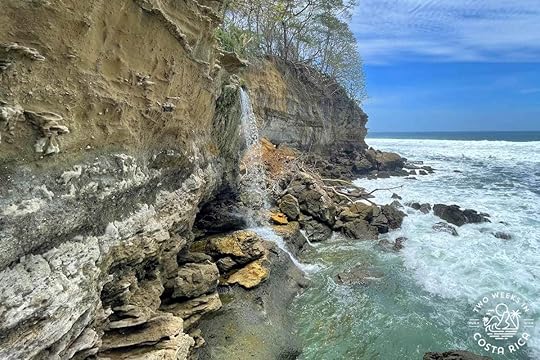
The largest tourist towns near El Chorro Waterfall (Catarata el Chorro) are Montezuma and Tambor on Costa Rica’s southern Nicoya Peninsula. These destinations are more remote and require longer travel days from the airport or other major towns in Costa Rica.
From San Jose Airport (SJO), the waterfall is about 4.5 hours away, including a ferry ride across the scenic Gulf of Nicoya. From Guanacaste Airport (LIR) near Liberia, the Chorro Waterfall is about 3.5 hours.
If you’re looking for places to stay nearby, be sure to check out our Montezuma and Tambor destinations guides. Santa Teresa on the other side of the peninsula is an option as well if you don’t mind a longer drive.
Why It’s SpecialEl Chorro Waterfall is unique because it falls directly into the ocean. These types of waterfalls are known as tidefalls. And they are rare—with only about 30 known worldwide.
 El Chorro Waterfall is one of around 30 tidefalls in the world
El Chorro Waterfall is one of around 30 tidefalls in the worldWhile uncommon, this is the second Costa Rican tidefall we’ve seen. The first was La Llorona Waterfall at the edge of Corcovado National Park. We caught a glimpse of that one on a boat ride to Sirena Ranger Station during a tour.
Websites about tidefalls don’t usually mention either of these Costa Rica waterfalls. They do, however, say that many are often remote and hard to see. That may have been the case with La Llorona, but El Chorro is only a short walk from the parking area. It’s easy to get to, though a little dangerous (more below).
Tip: Want to visit more waterfalls? Another one in this area you won’t want to miss is the Montezuma Waterfalls. You also can visit our Waterfalls page, which covers the best waterfalls all over Costa Rica.
Accessing El Chorro WaterfallDriving to El Chorro Waterfall is by far the most convenient option and what we’ll focus on in this post.
The drive from Montezuma is about 25 minutes. From Tambor, it’s only about 10 minutes. From a parking area, the walk to the top of the waterfall is around 10 minutes.
 Trail to the waterfall
Trail to the waterfallIf you are up for a much more adventurous option, you can hike north along the beach from Montezuma. This is almost 4 miles (6.25 km) each way, but beautiful with nothing but jungle and beach. Just be aware that it can be extremely hot and humid and there are no amenities along the way. We tried this years ago but ended up turning around just short of the falls because it was getting so late.
Some tour companies in Montezuma will also take you by horseback.
Driving DirectionsTo get to the trailhead, from Montezuma head inland to Cobano and take a right onto Route 160. Continue for about 5.6 miles (9 km). From Tambor, head southwest on Route 160 for about 3 miles (5 km).
From either direction, you’ll turn at a school called Escuela la Abuela and go toward the Tango Mar Beachfront Boutique Hotel (look for hotel signs).
The road is dirt, but flat. 4×4 is not necessary. Keep driving past the hotel, stay right, and continue to the end for about 5 minutes.
If you need to rent a car for your trip, be sure to check out our Rental Car Discount to save 10% through one of Costa Rica’s most reputable companies.
ParkingAt the end of the dirt road, you’ll find a small parking area that can hold about 10 cars. This lot didn’t have a parking attendant during our visit so make sure you don’t leave anything valuable inside to avoid break-ins. See our safety tips post for more information.
 The small parking area next to the trailheadThe Short Hike
The small parking area next to the trailheadThe Short Hike From the parking area, it’s a short 10-minute walk through the forest to the top of the waterfall.
The trail meanders through the jungle, along a fence, and winds down toward the ocean. If you come to a split in the trail early on, stay left.
Arriving at the WaterfallAt the end of the trail, we were a bit confused about where to go but luckily some locals were there so we could watch them.
If you go slightly to the left, you’ll be able to peek over the cliff and get a beautiful view of the waterfall and coastline toward Montezuma.
 View from the left side, higher up
View from the left side, higher upSafety Tip: El Chorro Waterfall cascades right over a cliff. When you visit, you’ll be accessing it from the top of the cliff, crossing a stream, and descending some steep rocky sections (see details below). There are no handrails or safety measures so watch your step and be extra cautious, especially with kids.
Crossing the Top of the WaterfallAt the end of the trail, go to the right and you’ll come to a small stream. You’ll need to cross this to get lower and see the waterfall. This was the confusing part for us because we hadn’t read about this!
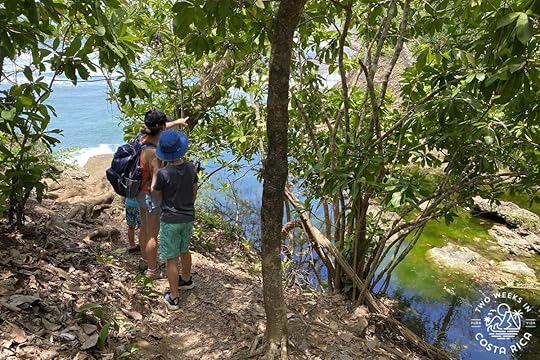 Trying to figure out the best route
Trying to figure out the best routeLuckily, we were visiting at the end of dry season (April), so the water was low and moving very slowly. Still, there was a lot of algae, making it slippery and a bit nerve-racking with our younger kids.
You are basically a few feet from the edge of the cliff, walking over slimy rocks, while the water that flows past you plummets over the waterfall to the rocks and ocean below. If you are visiting during rainy season, the water could be swift and potentially very dangerous. Don’t risk it if you aren’t sure.
 Crossing the stream to get to the trailAccessing the Bottom of the Waterfall
Crossing the stream to get to the trailAccessing the Bottom of the WaterfallAfter crossing the stream, you’ll follow a faint trail down a steep section of rocks and roots. This was a bit challenging because the trail was rustic but not as scary as crossing the top of the waterfall. Just take your time and make sure you have good footing before taking your next step.
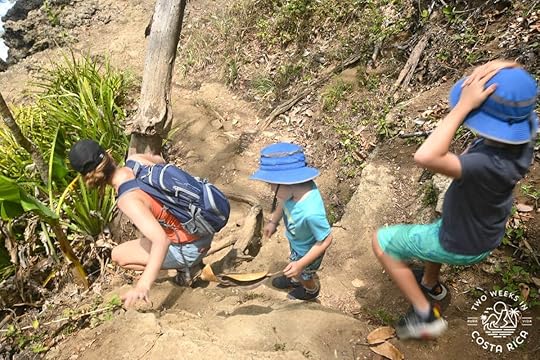 Climbing down to the waterfall viewpoint
Climbing down to the waterfall viewpointIn just five more minutes, you’ll reach some large flat rocks where you can relax and take in the view of the beautiful El Chorro Waterfall.
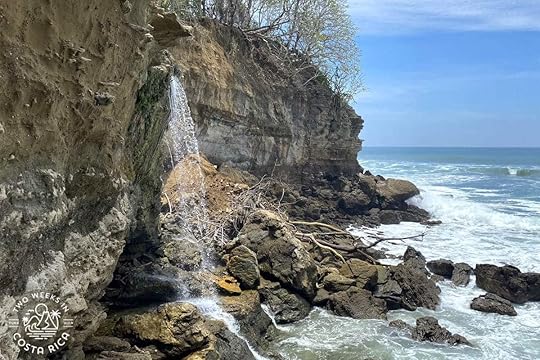 View from the rocks near the base/oceanCocalito Beach
View from the rocks near the base/oceanCocalito Beach If you want to keep climbing down the rocks towards the right, you can eventually reach Playa Cocalito. This is a pristine beach with fluffy tan sand. It’s best to visit during lower tides.
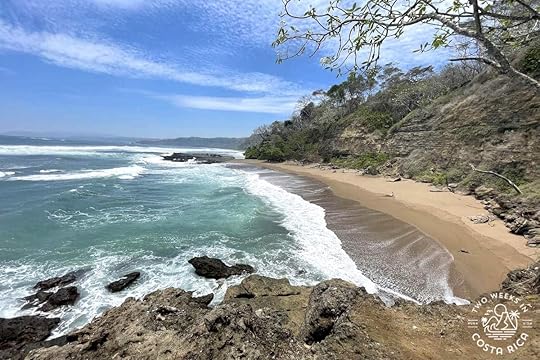 Cocalito Beach – accessible only at lower tides
Cocalito Beach – accessible only at lower tidesCocalito Beach is gorgeous but has big waves that can create strong rip currents. It’s better for splashing rather than swimming.
If you continue around the rocky point, the beach continues and there’s a small lagoon where another stream empties into the ocean.
What to Wear/BringGood-gripping shoes that you can easily take off/get wet when crossing the stream (something like Keens would be perfect)Hat, sunscreen, and insect repellentLightweight clothes or bathing suit if you plan to get wetWater and snacks (lots if you plan to do the long beach hike from Montezuma)Raincoat or poncho during rainy months (May-November)For more tips, see our Packing Your Daypack post.
ConclusionEl Chorro Waterfall is a quick and free activity that you can easily do from Montezuma or Tambor. You only need an hour or so to visit. As one of the only tidefalls in Costa Rica, it’s definitely worth the effort to climb along the rocks and see this unique cascade for yourself.
Have a question about visiting El Chorro Waterfall (Cocalito Falls) or want to share your story? Leave a comment below. Looking for more information to help you plan? Check out these posts:Curu National Wildlife Refuge – Not far from El Chorro Waterfall, this lesser-known private nature reserve has hiking trails, beaches, and lots of wildlife.
Bioluminescence in Costa Rica: A Kayak Tour on the Nicoya Peninsula – Near the ferry landing in Paquera, this night tour by kayak lets you see glowing algae.
Discovering Playa Muertos (Playa Vivos): A Hidden Beach with an Island Feel – For a local cultural experience, jump on a small boat near Tambor to get to this secluded beach.
Waterfalls in Costa Rica – Learn about other amazing waterfalls and see where they are on a map.
Things to Do – With over 150 articles covering activities like national parks, wildlife exhibits, hot springs, and coffee and farm tours, you’re sure to find lots to add to your list!
The post Catarata El Chorro: A Waterfall that Flows Into the Sea appeared first on Two Weeks in Costa Rica.
September 10, 2025
Hotel Belmar Review: Sustainable Luxury in Monteverde
Two Weeks in Costa Rica |
Our family recently stayed at Hotel Belmar in Monteverde, Costa Rica and were excited to experience one of the area’s most upscale sustainable ecolodges. Monteverde is known for its cloud forest environment, and we wanted to find a hotel that would let us enjoy this unique ecosystem while prioritizing conservation. Here’s our honest take on the hotel and what you can expect during your stay.
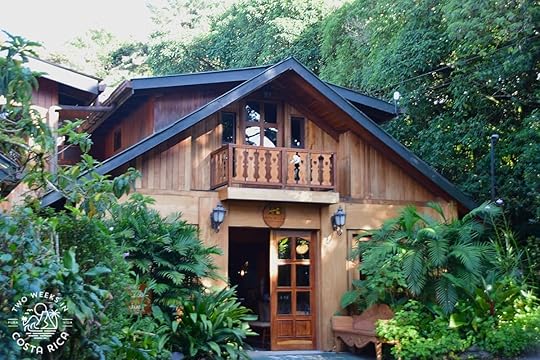
This is an unbiased review based on our personal experience. We paid for our stay and received no compensation. We share our honest opinions to help you plan your trip. Read more of our hotel reviews for properties all around Costa Rica.
OverviewHotel Belmar is a boutique luxury ecolodge nestled in the cloud forest. One of the first hotels to open in Monteverde back in 1985, the Belmar has a distinctive Austrian-inspired architectural design. The alpine-chalet style feels upscale yet cozy. Warm woods are used throughout the property, creating an inviting atmosphere.
One of the things we love most about Hotel Belmar is its sustainability efforts. The hotel operates as carbon neutral, has a farm-to-table restaurant, and focuses on regenerative travel – all things that we look for personally in a sustainable hotel.
Hotel Belmar is located right off the main road to the popular Monteverde Cloud Forest Reserve but set back on a hill so private. The large property has its own nature reserve. Its central location also makes it a great base for exploring other cloud forest reserves and activities in Monteverde.
The hotel has an on-site gourmet restaurant and sources its ingredients from its own organic farm and garden. While there’s no fitness center or pool (these aren’t common in Monteverde due to the cooler climate), the hotel has other activities on-site and offers some tours, including an authentic farm tour.
 Our family visiting the hotel farm’s vegetable garden
Our family visiting the hotel farm’s vegetable gardenThe hotel has 26 rooms and suites that are good for both couples and families. Many have outdoor porches to take advantage of the cloud forest views.
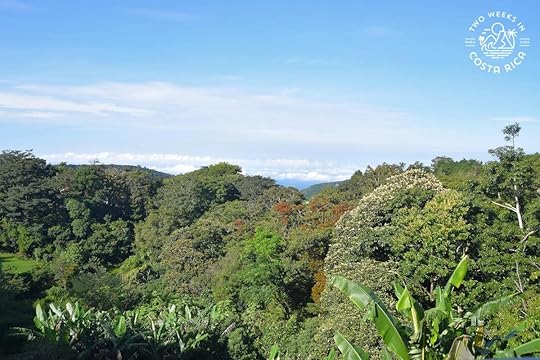 Beautiful views from the hotelLocation
Beautiful views from the hotelLocationHotel Belmar is located in Monteverde, one of Costa Rica’s most popular ecotourism destinations.
Monteverde is known for its lush cloud forest environment where low-level clouds come and go with the shifting winds. It is these misty conditions that create the perfect habitat for the unique plants and wildlife that make Monteverde famous.
 Monteverde’s lush, misty environment
Monteverde’s lush, misty environmentThe hotel is about 2.5 hours from both San Jose Airport and Guanacaste Airport in Liberia.
To get there, people typically take a shuttle or rent a car and drive. If you decide to rent a car, be sure to check out our Rental Car Discount to save 10% and get free extras.
The hotel is about 1.2 miles (2 km) from the main area of Santa Elena, making it convenient for accessing town, restaurants, and attractions. Our Monteverde destination guide has more information about the town, things to do, and local dining options.
 An agouti in one of Monteverde’s nature reservesCustomer Service
An agouti in one of Monteverde’s nature reservesCustomer ServiceWe found the customer service at Hotel Belmar to be excellent during our stay. The front desk staff were professional yet friendly. Check-in was smooth and informative, complete with a refreshing welcome drink and cool towel.
We enjoyed the turndown service each night. The locally made chocolates were delicious, and it was fun to get handmade soaps from a women’s cooperative.
Our stay was without problems except that we did have an issue with a nearby guest playing loud music at one point. We called the front desk, and they handled the situation quickly by personally asking the guest to turn it off.
The restaurant service was also wonderful throughout our stay. The servers were consistently friendly and welcoming, taking time to get to know our family during our three-night visit. They accommodated all our special requests without a problem.
Room Options at Hotel BelmarOverviewHotel Belmar has 26 rooms spread out among three buildings.
Main building: Where the restaurant and front desk are located.
Chalet: Just on the other side of the small access road (1-minute walk).
Nicoya building: Located separately high up on the hill, with a few Nicoya suites.
Rooms can hold 1-4 people (no room types can hold families of five).
If you have any mobility problems, the main building is the best option. The Chalet and Nicoya Suites require a walk up some stairs. Hotel Belmar does not have an elevator.
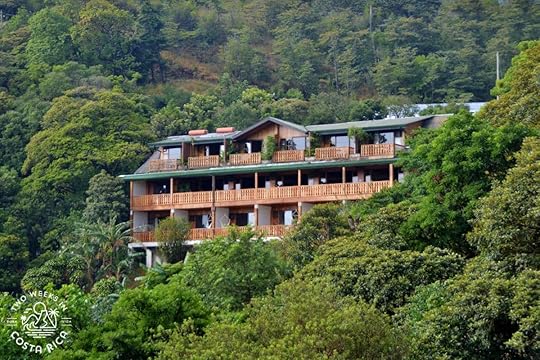 Main buildingMain Building
Main buildingMain BuildingPeninsula & Peninsula Superior – Peninsula rooms are one of the least expensive room types. 4 people max. 1 king or 2 queen beds. Peninsula rooms are on the lower floor. Peninsula Superiors are on the top floor.
Chalet BuildingForest & Forest Superior – Forest rooms are one of the least expensive room types. These have 1 king bed, but the hotel can add a queen-size daybed to the Forest Superior to accommodate up to 4 people. The Forest Superior has a Jacuzzi.
Canopy, Belmar, Sunrise, Sunset, and Cloud Forest Studios – Larger suites with 1 king bed and a tub. Can add a daybed to the Sunset, Canopy, and Cloud Forest Studio rooms to hold up to 4 people. These rooms vary, but all have separate sitting areas, a Jacuzzi or soaking tub (some inside, others outside), spacious bathrooms, and a terrace.
Nicoya Suites Building (Newest Building)Nicoya Suite and Nicoya Penthouse Suite – Most luxurious room type. Very large suites with 1 king, 1 sofa bed, and a large sitting area. Spacious terrace with Jacuzzi and daybed porch swing. Since it’s so high on the property, you can see all the way to the Pacific Ocean on clear days. Can hold up to 3 people.
Our RoomOur family stayed in a Cloud Forest Studio in the Chalet building and loved it.
It had floor-to-ceiling windows with a view to the cloud forest. The room was large, nicely decorated, and had a practical layout. It was great to have a separate sitting area, and we enjoyed the tub, which looked out to the lush forest. The room had a small porch, but we didn’t use it that much because the weather was cooler when we visited (September).
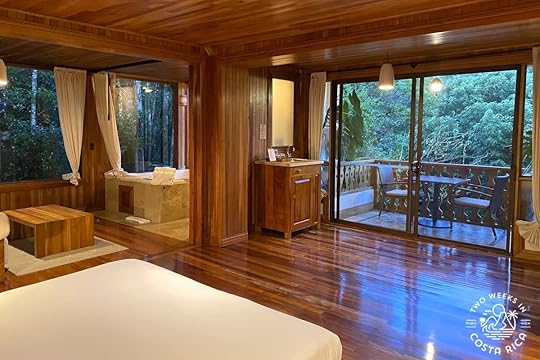 Our room – a Cloud Forest Studio
Our room – a Cloud Forest StudioBeds were very comfortable with nice linens. Our whole family enjoyed the organic aromatherapy bath products.
The hotel has done some renovations in recent years. The rooms now have a more contemporary feel than when we first toured the hotel several years ago.
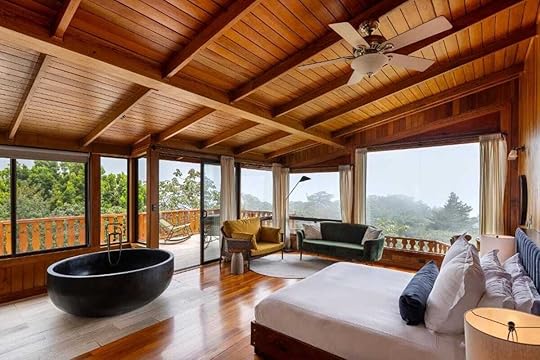 Sunrise Room. Photo Credit: Hotel Belmar
Sunrise Room. Photo Credit: Hotel BelmarAll rooms come equipped with a desk, traditional Costa Rican coffee maker, tea service, complimentary Wi-Fi, cotton slippers and bathrobes, safe, and minibar with local beverages (complimentary).
It’s important to know that none of the rooms at the Belmar have a TV or A/C. You don’t really need A/C in Monteverde since it’s cooler, but if you’re sensitive to the heat or humidity, you may want it.
The room was very clean when we arrived and cleaned daily during our stay.

Hotel Belmar is one of the more expensive hotels in Monteverde, with prices varying seasonally. The rainy season (May through November) offers the best rates.
In general, you can expect to pay $270-1,200 per night plus tax, with breakfast included. Check rates and availability at Hotel Belmar.
Peak season (Christmas/New Year’s and Easter Week) has the highest prices.
RestaurantsThe hotel has one main restaurant and a small brewpub located on the lower end of the property.
Main Restaurant (Restaurante Celajes)The hotel restaurant is upscale but not quite fine dining because the environment is more casual and comfortable and the food isn’t overly fussy, which we enjoyed. We’ve eaten at the restaurant a few times over the last several years, and the food has been consistently good.
 Bar and lounge area of the main restaurant
Bar and lounge area of the main restaurantRestaurante Celajes focuses on creating a satisfying, sustainable dining experience. Ingredients are sourced locally or freshly picked from their organic farm and garden.
They operate with zero waste and use ingredients that are often overlooked, which we can attest to. Our son’s fish fingers weren’t made from the standard mahi-mahi served at most restaurants in Costa Rica but from catfish.
The lunch and dinner menu is well-rounded with various chicken, beef, and fish dishes as well as several good vegetarian choices. We enjoyed the beef tenderloin and tarragon chicken. The Madre Tierra cheese plate is also amazing and showcases their farm’s signature cheeses.
 Steak with veggies
Steak with veggies Appetizer plate with farm-fresh cheeses
Appetizer plate with farm-fresh cheesesThey have a kids’ menu with basics like chicken and fish fingers, pasta, and burgers.
The restaurant has signature cocktails with house-made mixers. We loved the Tico Tonic made with herbs from their garden.
 Tico Tonic with lemon verbena, tarragon, mint, and Palo Santo
Tico Tonic with lemon verbena, tarragon, mint, and Palo SantoPrices are higher, especially for Costa Rica, but the quality of the food was very good.
Restaurant Pricing:Lunch entrees: $16-30 (salads, ceviche, casados, burgers, sandwiches)Dinner entrees: $22-35Main Restaurant Hours:Lunch: 12:00-3:00 p.m.Dinner: 5:30-10:00 p.m.Tico Time (Happy Hour): 4:00-5:00 p.m.Room service is available.
Cerveceria Belmar (Brewpub)The Belmar’s brewpub is a great casual dining alternative.
The brewpub overlooks a pond and has a small but well-curated menu with sandwiches, burgers, tacos, and snacks.
 View from the brewpub
View from the brewpubBeing a brewpub, you can of course try some of their delicious craft beer. We have enjoyed the tropical stout, IPA, and pale ale. They also offer mead, kombucha, wine, and cocktails.
Main dishes range from $7-17.
 A burger and beer at the hotel brewpubBrewpub Hours:Friday – Saturday: 12:00-9:00 p.m.Sunday – Thursday: 11:30 a.m.-7:00 p.m.Breakfast
A burger and beer at the hotel brewpubBrewpub Hours:Friday – Saturday: 12:00-9:00 p.m.Sunday – Thursday: 11:30 a.m.-7:00 p.m.BreakfastThe included breakfast is from a large a la carte menu. You start with fresh tropical fruit and can choose from things like traditional gallo pinto, Turkish eggs, breakfast sandwich with hollandaise sauce, avocado toast, homemade fruit pancakes, and French toast.
Everything incorporates house-made bread and tortillas plus local cheeses from their farm. The food was delicious all three mornings of our stay.
 Avocado toast
Avocado toastThe menu said that all items could be adapted for vegetarians or vegans.
Breakfast is served in the main restaurant, inside or outside on the porch with nice forest views.
Hours: 6:30-10:00 a.m.
Juice Bar and Tea RoomLocated in the Chalet building, this spot serves fresh tropical fruit and vegetable smoothies and juices made with organic ingredients. They also have simple foods like sandwiches, quiche, and bakery items.
Wellness CenterThe Wellness Center, also in the Chalet, has daily yoga classes ($20) and massage. One complimentary yoga class is included for guests.
The wellness space has windows that open right out to the cloud forest.
Massages are available by appointment, with prices starting at $80 for a 50-minute session.
Hotel Activities Onsite ActivitiesHotel Belmar offers a few complimentary activities on a rotating schedule, including coffee tasting (Monday), tropical mocktail class (Wednesday), and beer tasting (Friday). They also offer a cocktail class ($60).
Farm ExperienceOur family did the organic farm experience and loved it. Our young son (age 6) especially enjoyed his first horseback ride.
The tour gave us a real look at how they farm sustainably and had hands-on activities that our whole family enjoyed. We visited the vegetable gardens, sampled cheese, milked a cow, ground sugar cane into juice, saw coffee growing, and visited a chicken coop.
 The barn at Hotel Belmar’s farm
The barn at Hotel Belmar’s farmThe horseback riding took us along the ridge for some amazing valley views and even a rainbow! It was one of those unique tours that both the kids and adults really enjoyed. To learn more, visit our Farm Experience booking page.
 Our family on the horseback tour and farm experienceSavia Private Nature Reserve
Our family on the horseback tour and farm experienceSavia Private Nature ReserveHotel Belmar also offers several tours at their unique private reserve called Savia. Savia has a mix of trails, gardens, platforms, suspension bridges, and vertical rope climbing to explore the cloud forest’s many layers.
Unlike typical hanging bridges found elsewhere in Costa Rica, Savia maintains their sustainability focus through low-impact organic design.
Available experiences include morning tours, night tours, bird-watching, ficus tree climbing, and rappelling. Most combine nature walks with treetop experiences, with some tours adding food elements like breakfast in the canopy.
We didn’t make it to Savia on our last visit but have heard great things about it. Tours are around $110-270 per person.
Area ActivitiesMonteverde offers many activities within 5-25 minutes of the hotel, with options for different budgets. Here are some of our favorites:
Monteverde Cloud Forest Reserve – a 10-minute drive away, the most famous cloud forest reserve in the areaSanta Elena Cloud Forest Reserve – a 25-minute drive away, often less crowded than Monteverde ReserveCuri-Cancha Reserve – a 5-minute drive away, a great all-around reserve with birdwatching and wildlife viewingSelvatura Park – a 20-minute drive away, popular for hanging bridges and zip liningTreetopia Park – a 15-minute drive away, hanging bridges and high-adrenalin zip-lining adventuresMonteverde Butterfly Gardens – a 5-minute drive away, perfect for families and insect loversMonteverde Hummingbird Gallery – a 10-minute drive away, free stop to see hummingbirds flying all around youCoffee farm tours – Several options within 10-20 minutes, including Don Juan (coffee-chocolate-sugar cane combo) and Cafe Monteverde (sustainability focus).Read our Monteverde destination guide for more information or view the tours we book in Monteverde.
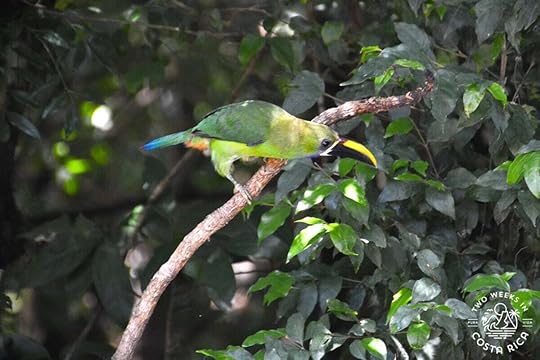 An emerald toucanet in MonteverdeWi-Fi
An emerald toucanet in MonteverdeWi-FiWe had good Wi-Fi in our room and throughout the property.
SustainabilityUnlike some other hotels, Hotel Belmar genuinely focuses on sustainability and regenerative travel. It’s not just marketing.
The hotel is carbon neutral with circular agriculture, water conservation, solar hot water heating, a plastics-free bar, natural pesticides, biodigester, and natural products for cleaning and personal care.
The hotel has the Certification for Sustainable Tourism in Costa Rica.
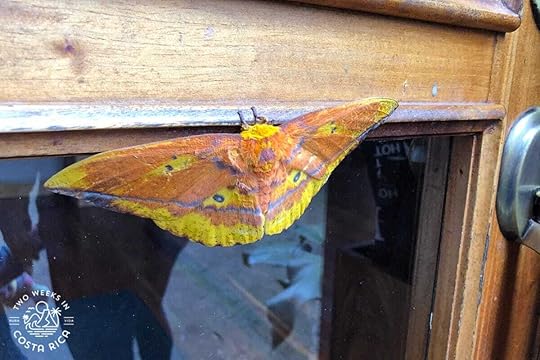 A beautiful moth we saw on the propertyValue for Money
A beautiful moth we saw on the propertyValue for MoneyConsidering Hotel Belmar’s luxury accommodations with updated decor and finishes, sustainability practices, and cloud forest location, we found it to offer good value within the high-end ecolodge category in Monteverde. The included breakfast added significant value.
A major benefit of this hotel is that they have their own nature reserve (Savia) and on-site activities.
Living in Costa Rica, we understand the extra costs that come with organic products and sustainable practices. We really appreciated their genuine commitment to sustainability. For travelers who prioritize conservation without compromising comfort, the Belmar is a great option.
That said, it is definitely a splurge. Budget-conscious travelers will find more affordable options in the Monteverde area. See our Monteverde Hotel Guide for recommendations.
Pros and Cons of Hotel BelmarPros:Good location with nice cloud forest views and reasonable distance to townCommitment to sustainability and carbon-neutral operationsOutstanding farm-to-table restaurantSpacious, well-designed rooms with large outdoor porchesExcellent customer serviceUnique Savia private nature reserveIncludes high-quality breakfastPeaceful, intimate atmosphereCons:ExpensiveRoom capacity maxes out at 4 people (no options for families of 5+)Savia reserve tours are quite expensive at $110-270 per personGetting to Hotel BelmarYou can fly into either Guanacaste Airport in Liberia or San Jose Airport, as they are about the same distance from Monteverde (around 2.5 hours).
DrivingDriving to Monteverde from either SJO or LIR takes about 2.5 hours. The route is mostly paved, main roads, except for the last hour or so. Once you get off the highway, you’ll take a curvy road through the mountains. It is paved but does have some potholes and rough spots. Check our post on Driving to Monteverde for more information.
If you’re coming from La Fortuna/Arenal, more of the drive is along rough, dirt roads.
We recommend a 4×4 or at least a higher-clearance SUV for the mountainous terrain.
Be sure to use our Rental Car Discount to save 10% and get free extras with one of Costa Rica’s most trusted rental companies.
Taking a ShuttleIf you don’t want to drive, private shuttles are a comfortable, stress-free option for getting to Hotel Belmar. These are air-conditioned vans with a professional driver. They include time to stop along the way as well. A private shuttle from San Jose or Liberia to Monteverde costs around $215.
If you need help with the arrangements, we work with reliable local shuttle companies and can help coordinate your transfer. Use the booking links below or contact us through our Private Shuttle Booking page.
 Guanacaste Airport (LIR) to Monteverde – Private Shuttle Van ServiceRated 5.00 out of 5 Price: From: $211.00 +VATSelect options
Guanacaste Airport (LIR) to Monteverde – Private Shuttle Van ServiceRated 5.00 out of 5 Price: From: $211.00 +VATSelect options
 La Fortuna (Arenal) to Monteverde – Shared Shuttle-Boat-Shuttle Service Price: From: $35.00 +VATSelect options
La Fortuna (Arenal) to Monteverde – Shared Shuttle-Boat-Shuttle Service Price: From: $35.00 +VATSelect options
 La Fortuna to Monteverde – Private Shuttle Van Service Price: From: $229.00 +VATSelect options
La Fortuna to Monteverde – Private Shuttle Van Service Price: From: $229.00 +VATSelect options
 La Fortuna to Monteverde – Private Shuttle-Boat-Shuttle ServiceRated 5.00 out of 5 Price: $316.00 +VATSelect options
La Fortuna to Monteverde – Private Shuttle-Boat-Shuttle ServiceRated 5.00 out of 5 Price: $316.00 +VATSelect options
 San Jose Airport (SJO) to Monteverde – Private Shuttle Van ServiceRated 5.00 out of 5 Price: From: $214.00 +VATSelect optionsBest Times to Visit
San Jose Airport (SJO) to Monteverde – Private Shuttle Van ServiceRated 5.00 out of 5 Price: From: $214.00 +VATSelect optionsBest Times to VisitAlthough still tropical feeling, Monteverde has a mild climate year-round due to its elevation, making it a great destination almost any time. Temperatures are in the 70s-80s°F (20-25°C), with cooler nights that drop down to the 60s°F (16-20°C). This cooler climate makes it a great contrast to Costa Rica’s hot beach towns.
The dry season (December through April) offers the best weather with less rain and clearer skies, though this is also high season when it’s busier.
The rainy season (May through November) has more rain, usually in the afternoons, but also fewer crowds and better hotel rates. September and October typically see the heaviest rainfall, though we have visited Monteverde in September and the weather was fairly good with most rain at night. Our post Rainy Season in Costa Rica: How Wet Is It? has more information.
ConclusionHotel Belmar is a luxury hotel in the cloud forest that sets itself apart with its sustainability. This was so nice for us to see, especially in Monteverde, a region already known for ecotourism. The service, cuisine, and unique tour experiences also make it stand out among Monteverde’s hotels. If you value sustainability without compromising comfort, Hotel Belmar is a great choice for exploring Costa Rica’s cloud forest.
Our Review PolicyThis review is based on our family’s personal experience at Hotel Belmar. We paid for our own accommodations and received no compensation or special treatment in exchange for this review. Our goal is to provide honest, unbiased information to help travelers make informed decisions about their Costa Rica accommodations.
Please note that if you book a stay at Hotel Belmar using our link to booking.com above, we receive a small commission at no extra cost to you. Read our Privacy Policy for more information.
Frequently Asked Questions How do I get to Hotel Belmar?You can rent a car (2.5 hours from San Jose or Liberia airports). See our Rental Car Discount page to save 10%. Or take a shared or private shuttle. Private shuttles for only your group are around $215 from either airport. Visit our Private Shuttle Booking page for help arranging transfers.
Do you need a rental car?Like most of the nicer hotels in Monteverde, Hotel Belmar is outside downtown Santa Elena where many restaurants are located. Since it’s not walking distance to many amenities, a rental car is nice to have.
If you don’t want to rent a car, though, you can easily get around since town is only about 5-10 minutes away. Taxis are available and the front desk can help you arrange one. For activities off the hotel property, most tour companies include transportation or offer it for a reasonable fee.
What should I pack for a stay at Hotel Belmar?Pack a raincoat year-round since rain is common in the cloud forest, lightweight pants for hiking and cooler evenings, layering tops (T-shirts work for daytime but it can cool with shifting clouds), and hiking boots or sneakers. Don’t forget binoculars for bird-watching. Read our post on packing for Costa Rica for more information.
What are the restaurant hours?Main Restaurant: Lunch 12:00-3:00 p.m., Dinner 5:30-10:00 p.m., Happy Hour 4:00-5:00 p.m.
Brewpub: Friday-Saturday, 12:00-9:00 p.m., Sunday-Thursday 11:30 a.m.-7:00 p.m.
Breakfast: 6:30-10:00 a.m.
Can I drink the water at Hotel Belmar?Yes, the water at the hotel and throughout Monteverde is safe to drink. Learn more about drinking water safety in Costa Rica.
Can you see wildlife on the property?Yes, it’s definitely possible! Monteverde is a great destination for wildlife viewing. It’s possible to see monkeys, agoutis, coatis, snakes, and various birds, including toucans, hummingbirds, mot-mots, parrots, and even the famous Resplendent Quetzal.
For the best wildlife viewing opportunities, we’d recommend doing a guided tour at Savia or another reserve in Monteverde. Naturalist guides are especially important in Monteverde since wildlife is often hidden or high in the canopy.
Is parking free?Yes. The main building and Chalet building have their own complimentary parking areas. The Nicoya Suites don’t have a separate lot but the staff can help with bags.
What are the check-in and check-out times?Check-in: 3:00 p.m. Check-out: 12:00 p.m.
{"@context":"https:\/\/schema.org","@type":"FAQPage","mainEntity":[{"@type":"Question","name":"How do I get to Hotel Belmar?","acceptedAnswer":{"@type":"Answer","text":"<p>You can rent a car (2.5 hours from San Jose or Liberia airports). See our <a href=\"https:\/\/www.twoweeksincostarica.com\/costa-ri... Car Discount<\/a> page to save 10%. Or take a shared or private shuttle. Private shuttles for only your group are around $215 from either airport. Visit our <a href=\"https:\/\/www.twoweeksincostarica.com\/costa-ri... Shuttle Booking<\/a> page for help arranging transfers.<\/p>"}},{"@type":"Question","name":"Do you need a rental car?","acceptedAnswer":{"@type":"Answer","text":"<p>Like most of the nicer hotels in Monteverde, Hotel Belmar is outside downtown Santa Elena where many restaurants are located. Since it\u2019s not walking distance to many amenities, a rental car is nice to have.<\/p><p>If you don\u2019t want to rent a car, though, you can easily get around since town is only about 5-10 minutes away. Taxis are available and the front desk can help you arrange one. For activities off the hotel property, most tour companies include transportation or offer it for a reasonable fee.<\/p>"}},{"@type":"Question","name":"What should I pack for a stay at Hotel Belmar?","acceptedAnswer":{"@type":"Answer","text":"<p>Pack a raincoat year-round since rain is common in the cloud forest, lightweight pants for hiking and cooler evenings, layering tops (T-shirts work for daytime but it can cool with shifting clouds), and hiking boots or sneakers. Don\u2019t forget binoculars for bird-watching. Read our post on <a href=\"https:\/\/www.twoweeksincostarica.com\/packing-... for Costa Rica<\/a> for more information.<\/p>"}},{"@type":"Question","name":"What are the restaurant hours?","acceptedAnswer":{"@type":"Answer","text":"<p><strong>Main Restaurant:<\/strong> Lunch 12:00-3:00 p.m., Dinner 5:30-10:00 p.m., Happy Hour 4:00-5:00 p.m.<\/p><p><strong>Brewpub:<\/strong> Friday-Saturday, 12:00-9:00 p.m., Sunday-Thursday 11:30 a.m.-7:00 p.m.<\/p><p><strong>Breakfast:<\/strong> 6:30-10:00 a.m.<\/p>"}},{"@type":"Question","name":"Can I drink the water at Hotel Belmar?","acceptedAnswer":{"@type":"Answer","text":"<p>Yes, the water at the hotel and throughout Monteverde is safe to drink. Learn more about <a href=\"https:\/\/www.twoweeksincostarica.com\/costa-ri... water safety<\/a> in Costa Rica.<\/p>"}},{"@type":"Question","name":"Can you see wildlife on the property?","acceptedAnswer":{"@type":"Answer","text":"<p>Yes, it’s definitely possible! Monteverde is a great destination for wildlife viewing. It\u2019s possible to see monkeys, agoutis, coatis, snakes, and various birds, including toucans, hummingbirds, mot-mots, parrots, and even the famous <a href=\"https:\/\/www.twoweeksincostarica.com\/resplend... Quetzal<\/a>.<\/p><p>For the best wildlife viewing opportunities, we\u2019d recommend doing a guided tour at Savia or another reserve in Monteverde. <a href=\"https:\/\/www.twoweeksincostarica.com\/naturali... guides<\/a> are especially important in Monteverde since wildlife is often hidden or high in the canopy.<\/p>"}},{"@type":"Question","name":"Is parking free?","acceptedAnswer":{"@type":"Answer","text":"<p>Yes. The main building and Chalet building have their own complimentary parking areas. The Nicoya Suites don\u2019t have a separate lot but the staff can help with bags.<\/p>"}},{"@type":"Question","name":"What are the check-in and check-out times?","acceptedAnswer":{"@type":"Answer","text":"<p>Check-in: 3:00 p.m. Check-out: 12:00 p.m.<\/p>"}}]} Have a question about Hotel Belmar or have you been? Leave a comment below. Looking for more information about Costa Rica? Check out these posts:Cloud Forest Lodge: Eco-luxury in Monteverde – Our review of another high-end hotel in town.
Sustainable Hotels in Costa Rica – Our article on Costa Rica’s sustainable tourism program and other sustainable hotels all around the country.
Hotel Guides and Reviews: Read our other hotel guides for popular destinations like Manuel Antonio and La Fortuna/Arenal.
Best Hotels for Families in Costa Rica: If you’re traveling with kids, these are our top recommendations for all budgets. Includes ecolodges, treehouses, five-star resorts, and everything in between.
Parador Resort and Spa Review: Detailed guide for this large upscale resort near Manuel Antonio Beach.
Practical Travel: Get more travel basics, including currency, exchange rate, safety, and tips on staying in vacation rentals.
The post Hotel Belmar Review: Sustainable Luxury in Monteverde appeared first on Two Weeks in Costa Rica.
September 3, 2025
Monteverde Butterfly Gardens: Up Close with Insects and Butterflies
Two Weeks in Costa Rica |
If you’re looking to see butterflies on your trip to Costa Rica, the Monteverde Butterfly Gardens is the perfect spot. Our family has visited these gardens a few times, and it’s become one of our go-to recommendations for families exploring the area. In this post, we’ll tell you what to expect at the Monteverde Butterfly Gardens and how to plan a visit.

The Monteverde Butterfly Gardens is located in Monteverde, Costa Rica, a famous ecotourism destination known for its misty cloud forest. Monteverde is about 2.5 hours from both San Jose Airport and Guanacaste Airport in Liberia.
Monteverde is an excellent wildlife destination with lots of animals and especially birds within its many nature reserves. Although wildlife is abundant, it’s often hard to see in Monteverde’s dense forests. Fortunately, around town, you can find wildlife exhibits that let you see animals close up. The Monteverde Butterfly Gardens is one of the best spots.
The gardens are located about 10 minutes outside the main area of Santa Elena at the end of a quiet side road.
If you’re planning to rent a car for your time in Monteverde, be sure to check out our rental car discount to save 10% and get free extras.
Note: The butterfly garden we’re discussing here is the standalone attraction called the Monteverde Butterfly Gardens (Jardin de Mariposas). There’s another butterfly garden in Monteverde at Selvatura Park, which also has popular hanging bridges, zip lining, and a sloth sanctuary.
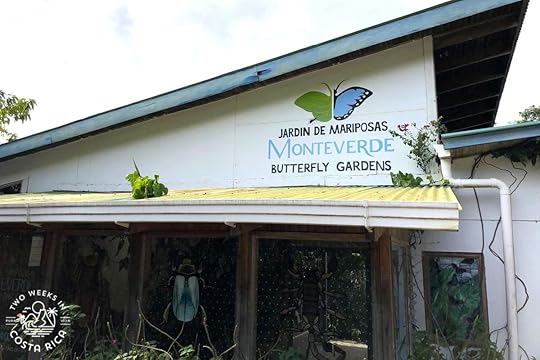 Arriving at the Monteverde Butterfly GardensThe Monteverde Butterfly Gardens TourGetting Started
Arriving at the Monteverde Butterfly GardensThe Monteverde Butterfly Gardens TourGetting StartedAfter checking in, we met our guide. On our most recent visit, our guide was Leah, an enthusiastic volunteer from the U.K. Right away we could tell that Leah was really passionate about entomology and loved sharing her knowledge.
Insect ExhibitsThe tour began in the insect exhibit, a room filled with several enclosures housing interesting bugs native to Costa Rica. These included tarantulas, scorpions, stick bugs, and even cockroaches. We learned cool facts about these creatures that gave us a whole new appreciation for them.
 Checking out the insect exhibit
Checking out the insect exhibitOne of the main goals of the Monteverde Butterfly Gardens is to educate people about the importance of insects in our environment and show just how amazing they really are.
An especially interesting creature we saw was a female orange-kneed tarantula. This particular spider was an impressive 18 years old!
 The 18 year old tarantula
The 18 year old tarantulaWe also saw displays with beautiful jewel beetles, which have shiny, bright green bodies, and some giant rhinoceros beetles. These beetles, we learned, use their large horns to fight with other males over potential mates.
 Rhinoceros beetles
Rhinoceros beetlesOur six-year-old was particularly interested in the butterfly chrysalis display, where the staff places cocoons gathered from the butterfly enclosures. It was fascinating to watch butterflies begin to emerge from their cocoons.
 Watching some butterflies come out of their chrysalis
Watching some butterflies come out of their chrysalisNote: The Monteverde Butterfly Garden is a safe spot to visit, but if you’re feeling uneasy about insects and spiders in the wild, check out our post Bugs, Spiders, and Snakes in Costa Rica: What to Expect.
Butterfly ExhibitsAfter the insect room, Leah led us through four different butterfly gardens, each representing a different ecosystem in Costa Rica. These gardens house over 30 different types of butterflies.
 Walking to the butterfly gardensBeach Enclosure
Walking to the butterfly gardensBeach EnclosureThis warmer environment replicates what you’d find in Costa Rica’s beach areas.
It’s a well-insulated greenhouse where you can see many types of butterflies that live in coastal areas, like Blue Morphos and Owl butterflies. We also saw several caterpillars.
The enclosure had beautiful landscaping with flowers and tropical plants, plus feeders set up with fresh fruit that the butterflies enjoy.
 The beach enclosure
The beach enclosure A beautiful Blue MorphoMid-elevation Enclosure
A beautiful Blue MorphoMid-elevation EnclosureThis enclosure represented a typical garden—what Leah called “grandma’s garden.” It showcased butterflies from Costa Rica’s middle elevations. This one had many gorgeous long-winged butterflies. They feed on nectar and pollen instead of fruit.
 A butterfly landing on usForest Understory
A butterfly landing on usForest UnderstoryThis enclosure had several glasswing butterflies, which we learned are transparent to avoid predators. This characteristic can also make it hard for them to find a mate, though. To help with this, the males use their pheromones to gather together in a display to attract females.
 One of Costa Rica’s coolest butterflies, the glasswingCloud Forest
One of Costa Rica’s coolest butterflies, the glasswingCloud ForestIn this open enclosure, the temperature was the same as outside, so it had butterflies adapted to Monteverde’s cooler climate.
 Cloud forest enclosure with local species
Cloud forest enclosure with local speciesImportant: Although you’ll see plenty of butterflies, the Monteverde Butterfly Gardens doesn’t overfill the enclosures like some other butterfly gardens do. This is so that the butterflies don’t get stressed.
Wrapping UpAfter the final exhibit, we walked along a forest trail and saw some beautiful, mature trees, including a giant stranger fig.
 Giant strangler fig tree
Giant strangler fig treeThe tour ended at the gift shop, which had unique insect-themed items from T-shirts and bags to stuffed animals and toys. We picked up a couple of fun mementos for our kids.
Traveling with kids? Be sure to check out our Costa Rica with Kids page for more family-friendly things to do and travel tips.
Planning Your Visit to the Monteverde Butterfly GardensCostAdults: $20Students: $14Youth ages 7-18: $12Children ages 4-6: $6Children under 3: FreeAdvanced reservations aren’t required, but if you’d prefer to buy tickets online, you can do so through Viator.
 Blue Morpho with closed wingsHours
Blue Morpho with closed wingsHoursOpen every day. Tours are offered from 9:00 a.m. to 3:30 p.m. The last tour is at 3:30 p.m. Tours last about 1.5 hours.
What to Bring/WearComfortable shoes and a camera. If you want to wear insect repellent, be sure to apply it before you arrive.
ConclusionThe Monteverde Butterfly Gardens makes for a great, quick activity, especially if you have kids. It’s an educational and entertaining way to learn about Costa Rica’s incredible insect diversity while getting up close with some beautiful butterflies.
If you book a tour through Viator using the link above, we get a small commission. This doesn’t cost you anything extra and helps us keep providing information on this website for free. Thanks for your support!
Have a question about visiting the Monteverde Butterfly Gardens or have you been? Leave a comment below.Looking for more information to plan your trip? Check out these posts:Finca El Paraíso Farm Tour: This organic dairy farm tour will get you up close and personal with cows and other animals, plus it includes a cheesemaking component.
Don Juan Coffee Tour: This interactive coffee, chocolate, and sugar cane tour is one of our favorites in Monteverde.
Monteverde Hummingbird Gallery: This is another fun, quick stop to see hummingbirds zipping all around you.
Monteverde Tours: View all the tours in Monteverde that we can help you book.
Wildlife Activities: Get more options for activities to see wildlife in Costa Rica. Safari floats, crocodile tours, wildlife sanctuaries, and lots more.
Things to Do: Plan your activities with our Things to Do articles. We cover 150+ attractions all around Costa Rica.
The post Monteverde Butterfly Gardens: Up Close with Insects and Butterflies appeared first on Two Weeks in Costa Rica.
August 26, 2025
Cloud Forest Lodge Review: Eco-luxury in Monteverde
Two Weeks in Costa Rica |
Our family recently stayed at Cloud Forest Lodge in Monteverde and was excited to experience one of the area’s more upscale ecolodges. Monteverde is known for its incredible cloud forest environment, and we wanted to find a hotel that would let us enjoy this unique ecosystem while still having comfortable accommodations. Here’s our honest take on the lodge and what you can expect during your stay.
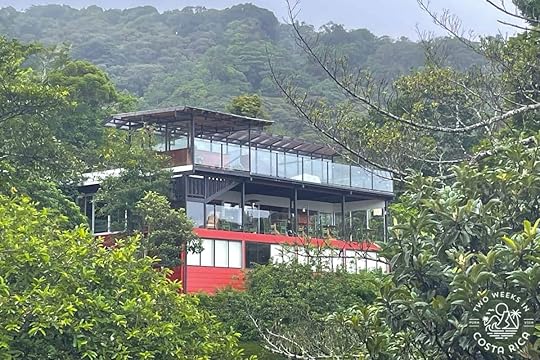
Note: This is an unbiased review based on our personal experience. We paid for our stay at Cloud Forest Lodge and received no compensation. We share our honest opinions to help you plan your trip. Read more of our hotel reviews for properties all around the country.
OverviewCloud Forest Lodge is a small, upscale ecolodge nestled high on a hill in Monteverde, surrounded by pristine cloud forest. Despite feeling secluded and immersed in nature, the lodge is conveniently located. It’s about a 10-minute drive to downtown Santa Elena where you’ll find restaurants, shops, and other amenities.
The property sits on a 23-hectare (57-acre) private nature reserve with trails. This creates a tranquil and peaceful atmosphere that takes you away from the hustle and bustle of the busier main area of town. Whether you’re planning to visit the hanging bridges, go zip lining, or explore the various nature reserves in the area, Cloud Forest Lodge puts you right in the heart of it all.
 Amazing cloud forest all around the hotel
Amazing cloud forest all around the hotelThe lodge has only 25 suites, which keeps things intimate and ensures it won’t feel crowded. The rooms themselves are simple but comfortable, and each has a large outdoor porch where you can relax and take in the cloud forest surroundings.
One of the highlights of our stay was the on-site farm-to-table restaurant and the great service that came with it. The food quality and dining experience was wonderful.
It’s worth noting that Cloud Forest Lodge doesn’t have some amenities you might find at other hotels. There’s no spa, fitness center, or pool. But this is typical for Monteverde, where the cooler cloud forest climate doesn’t call for pools, and the focus is on experiencing nature.
The lodge is owned by the Costa Rica hotel group Boena, which has other well-regarded properties like its sister property the Monteverde Lodge as well as Tortuga Lodge in Tortuguero, Lapa Rios Lodge on the Osa Peninsula, and Pacuare Lodge.
Cloud Forest Lodge Costa Rica: Location & AccessCloud Forest Lodge is located in Monteverde, one of Costa Rica’s most popular and well-established ecotourism destinations.
The lodge is about 2.5 hours from both San Jose Airport and Guanacaste Airport in Liberia (LIR). Most visitors arrive by taking a shuttle or renting a car and driving themselves. If you’re planning to rent a car, be sure to check out our rental car discount to save 10% and get free extras.
The lodge is only about two kilometers (1.2 miles) from the main area of Santa Elena, so you’re in a convenient location for accessing town, restaurants, shops, and attractions. The short drive means you can easily head into town for dinner if you want to try some of the local restaurants, or stock up on any supplies you might need. Our Monteverde destination guide has detailed information about the town, all the things to do in the area, and restaurant recommendations.
Visiting Costa Rica for the first time? Be sure to check out our post First-Time Visit to Costa Rica: Why You Should Go and What to Expect for helpful information to jump-start your planning.
Customer ServiceWe found the customer service at Cloud Forest Lodge to be good, though there were some inconsistencies. The front desk staff could have been more friendly and welcoming, but they did a thorough job of explaining the hotel’s amenities and helping us get oriented. Upon arrival, we were offered a welcome drink of fresh tropical fruit juice.
 Map of the property
Map of the propertyWhere the service shined was in the restaurant. The breakfast and dinner staff were the same people, and over the course of our stay, they got to know our family. They asked about our trip, took a genuine interest in learning more about us, and made us feel welcome. This personal attention from the restaurant team was one of the highlights of our stay.
Room Options at Cloud Forest Lodge in MonteverdeThe rooms at Cloud Forest Lodge are spread across a few small buildings that are all near each other. The convenient layout means that the rooms, restaurant, and reception are in the same area and within less than a minute’s walk of each other.
 The walkway from Reception to the rooms
The walkway from Reception to the roomsThe lodge offers three different room types. We found it a bit difficult to understand from their website which rooms would work best for families, so we ended up talking to the Reservations Department for clarification.
All the rooms are named after local bird species that can be found in Monteverde.
Manakin Suites are the least expensive room type and can hold up to 4 people. They come with either 1 king bed or 2 double beds and are 66 square meters (710 sq ft).
Euphonia Suites are the mid-level option with 2 queen beds and the option to add 1 twin bed. These rooms are 72 square meters (775 sq ft) and can hold up to 5 people.
Tityara Suites are the most expensive room type, with 1 king bed, 1 day bed, and the option to add an extra twin. At 80 square meters (861 sq ft), they can hold up to 5 people.
Our family stayed in a Euphonia Suite and were amazed by how huge it was! Even with an added twin bed for our kids, there was still plenty of space to move around. The bathroom was also enormous. It seemed like they could have used the space more efficiently, but since this property was purchased and renovated rather than built from scratch, that explains the layout. As a family of four, we appreciated having all that extra room to spread out.
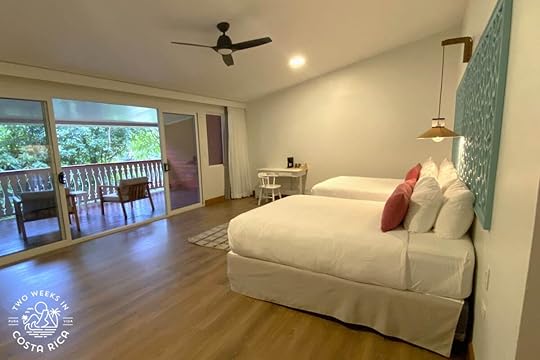 Our room – a Euphonia Suite
Our room – a Euphonia SuiteThe decor was minimalist and understated. While there wasn’t a lot of decoration, the bed frame was colorful and had a tropical feel that fit well in Costa Rica.

The beds were comfortable with nice linens and thick duvets, plus extra blankets for Monteverde’s cooler nights. Each room comes equipped with a desk, coffee maker, safe, ceiling fan, and space heater – the heater is important for those cool cloud forest nights!
One thing we missed was a mini fridge, which wasn’t available in the rooms. Rooms also do not have a TV.
The toiletries provided in the shower were from a nice local brand called Aromas that we actually use at home. They use natural ingredients and essential oils, and smell great.
We all loved spending time on the large outdoor porch that overlooked some trees. During our stay, we saw some beautiful motmots (birds) one day and even spotted a family of coatis (raccoon-like animals) passing right in front of our porch.
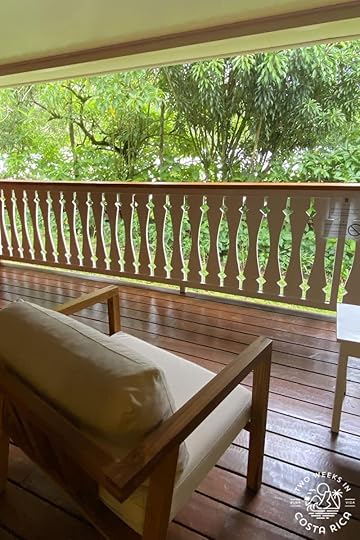 Porch with comfortable sitting area
Porch with comfortable sitting areaThe rooms were clean and quiet throughout our stay.
CostCloud Forest Lodge is one of the more expensive hotel options in Monteverde. As with most hotels in Costa Rica, prices vary seasonally, with the rainy season (May through mid-November) offering the best rates.
In general, you can expect to pay $270-600 per night plus tax, depending on the season and room type. These rates include breakfast, which is a nice value-add. Check Rates and Availability at Cloud Forest Lodge.
Peak season pricing applies during Christmas/New Year’s and Easter Week when rates are the highest.
Endemica RestaurantThe hotel has just one restaurant, but it’s gorgeous. The space features beautiful local wood and has an inviting fireplace at the entry that creates a cozy atmosphere. It’s a perfect spot to grab a drink and relax after a day of exploring.
 Dining room
Dining room Our son checking out the fireplace
Our son checking out the fireplaceThe restaurant has beautiful forest views that enhance the dining experience.
The restaurant focuses on local fusion cuisine – hence the name Endemica, meaning “endemic.” They source most of their fruits and vegetables from local farms in the Monteverde area and use sustainable meats and seafood whenever possible.
The menu offers a lot of variety with entrees ranging from risotto with smoked pork belly and local mushrooms to homemade shrimp and goat cheese tortellini, sea bass with local pejibaye curry, and ossobuco.
There are many options for vegetarians and vegans. They even have a dedicated plant-based menu. We tried the chickpea gnocchi with local mushrooms and corn polenta with vegan sausage from the plant-based menu, and both dishes were excellent.
The overall dining experience was outstanding, including complimentary bread for the table and both a complimentary appetizer and dessert.
 Mini-bruschetta with local cheese appetizer
Mini-bruschetta with local cheese appetizerOne thing that stood out was their large wine cellar, one of the biggest we’ve seen in Costa Rica.
The prices are on the higher side, especially for Costa Rica, but the food and dining experience was really good.
For lunch, entrees range from 10,500-16,000 colones ($21-32), while pizzas, sandwiches, and burgers are 9,000-11,000 colones ($18-22).
Dinner entrees range from 11,000-20,000 colones ($22-40).
They also have a large children’s menu with familiar options like Bolognese pasta, pesto pasta, chicken and fish fingers, and burgers.
The restaurant is open for three meals a day from 6:30 a.m. to 9:00 p.m. every day. Room service is also available, and they have a small snacks menu for lighter options between meals.
BreakfastWe enjoyed the complimentary breakfasts each morning. To start, we were given a fresh fruit plate and homemade toast with marmalade for the table. Then we could order whatever we wanted from an a la carte menu.
 The breakfast starter
The breakfast starterThe menu had things like homemade yogurt and granola, traditional Costa Rican gallo pinto, omelets, French toast, pancakes, breakfast sandwiches, and breakfast burritos. Everything was made with homemade bread and tortillas, plus local cheese.
 Traditional breakfast plate of gallo pinto
Traditional breakfast plate of gallo pintoWe appreciated that dietary restriction information was noted on the menu, and the servers asked right away if we had any special dietary needs. They accommodated our requests without any issues.
Fresh orange juice, hot chocolate for the kids, and French press coffee were all included. They also offered specialty coffee drinks for an additional charge.
One of the fun parts of breakfast was watching hummingbirds and other birds come to the feeders while we ate. It was like having our own nature show!
Breakfast is served at the main restaurant from 6:30-9:30 a.m.
 Breakfast with a viewOutdoor Porch
Breakfast with a viewOutdoor PorchThere’s a large outdoor porch above the restaurant that overlooks the cloud forest. It’s a nice place to hang out and relax. It had a fire pit, but they didn’t have it going on our visit. The porch is oriented towards the west, so if the weather is nice, you can enjoy nice sunsets as well.
Nature Reserve and Trails at Cloud Forest LodgeThe lodge sits on a vast 23-hectare (57-acre) private reserve that backs right up to the accommodations. The property is part of an important biological corridor called the Bellbird Biological Corridor, which helps migratory animals like big cats move between different areas.
There are three trails on the property for a total of 4 kilometers (2.5 miles).
We hiked the Pizote and Aguacate Trails, which took us about two hours. The trails are well-maintained dirt paths that wind through the cloud forest, showcasing the ecosystem where plants grow on top of other plants. The amount of moss and lichen throughout this moisture-rich environment is amazing, and we saw many grand, ancient trees.
 Exploring the onsite trails
Exploring the onsite trailsWe didn’t spot much wildlife during our hike, but we’re sure there’s plenty to see if you’re patient and keep your eyes open.
The trails are open daily from 6 a.m. to 5 p.m.
Activities On-siteRight on the property is a zip-line tour called the Original Canopy Tour. You can see people zipping by right from the restaurant, which is fun. The lodge also offers guided night tours and bird-watching tours for guests.
Monteverde Area ActivitiesThe Monteverde area has tons of activities within 10-25 minutes of the hotel. Here are some of the most popular things to do:
Hiking in the many nature reserves like the Monteverde Cloud Forest Reserve, Curi-Cancha Reserve, and Santa Elena Cloud Forest ReserveWalking hanging bridges and zip lining at Selvatura Park and Treetopia ParkTaking coffee, chocolate, and sugar cane farm toursGoing on night tours to spot nocturnal wildlifeVisiting the Monteverde Hummingbird GalleryExploring the Monteverde Butterfly GardenFor information about all the area activities, read our Monteverde destination guide, or check out the tours we can help you book in Monteverde.
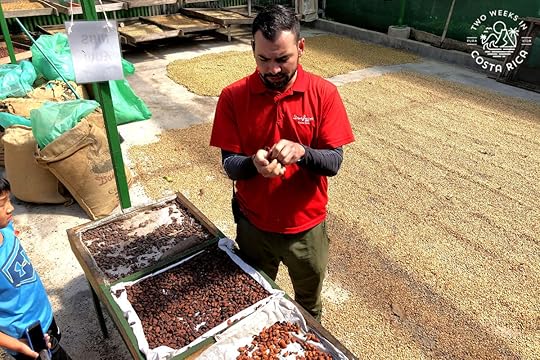 Local coffee and chocolate tour in MonteverdeActivities for Kids
Local coffee and chocolate tour in MonteverdeActivities for KidsThe lodge doesn’t have a lot of kid-specific things to do, but there is a small lounge area in the restaurant with some games. The trails on the property are also good for taking kids on nature walks. They’ll love spotting the birds from the restaurant and their room porches too.
Traveling with kids? Be sure to check out our Costa Rica with kids page for family-friendly things to do and helpful tips.
Wi-FiThe Wi-Fi signal was strong in our room and throughout the property. The internet is complimentary for guests.
ParkingParking at the Cloud Forest Lodge is free. They have a gravel parking lot that is monitored by security cameras.
 The walkway from the parking lot to the hotelSustainability
The walkway from the parking lot to the hotelSustainabilityThe Boena hotel group and Cloud Forest Lodge are committed to sustainability. They focus on conservation of land, reforestation, and use solar electricity. The construction methods are designed to be low-impact, they source biodegradable products locally when possible, and make a point to employ local community as staff. They also do community outreach in local schools.
All guests pay a small conservation fee as part of their stay, which goes directly towards their sustainability efforts.
The lodge has an electric vehicle charging station for guests.
Nearby AttractionsThe Monteverde area is packed with attractions, most within a 15-minute drive of Cloud Forest Lodge:
Monteverde Cloud Forest Reserve – 15 minutes away, the most famous reserve in the area Santa Elena Cloud Forest Reserve – 20 minutes, often less crowded than Monteverde Curi-Cancha Reserve – 10 minutes, excellent for birdwatchingSelvatura Park – 20 minutes, popular for hanging bridges and zip liningTreetopia Park – 20 minutes, popular for hanging bridges and zip liningCoffee Farm tours – Multiple options within 15-20 minutesMonteverde Butterfly Garden – 8 minutes Monteverde Hummingbird Gallery – 15 minutesValue for MoneyConsidering Cloud Forest Lodge’s upscale accommodations, prime location, and great restaurant, we found it to be a good value within the high-end ecolodge category in Monteverde. The fact that breakfast was included was key.
The property’s 23-hectare private reserve with trails adds value as well. Having direct access to the cloud forest is a major benefit.
That said, this is definitely a splurge accommodation. Many other options are available in the area for budget travelers. See our Monteverde Hotel Guide for recommendations.
The hotel’s restaurant prices are high even for this category. If you want to keep expenses down, just visit one of the many restaurants in Monteverde for much more affordable local dining.
Pros and Cons of Cloud Forest Lodge in MonteverdePros:Stunning location surrounded by pristine cloud forestComfortable and spacious rooms with large outdoor porchesOutstanding restaurant with local fusion cuisine and great serviceLarge private nature reserve with well-maintained trailsPeaceful, intimate setting with only 25 suitesConvenient location just 10 minutes from Santa ElenaIncludes breakfastCommitment to sustainability and conservationCons:High pricesFront desk service could be more welcoming and friendlyLimited on-site amenities (no pool, spa, or fitness center)No mini fridge or TV in roomsMain parking area requires a 3-5-minute walk to ReceptionOnly one restaurant option on property The greenhouse lit up at nightGetting to Cloud Forest Lodge
The greenhouse lit up at nightGetting to Cloud Forest LodgeYou can fly into either Guanacaste Airport in Liberia or San Jose Airport. Both are about the same distance from Monteverde at around 2.5 hours.
DrivingThe drive to Monteverde from either airport is along mostly well-maintained, paved roads. The last part of the drive (about one hour) is on a curvy mountain road. It’s in fairly good condition but does have some potholes and uneven terrain.
If you’re coming from La Fortuna/Arenal instead, parts of the drive are along rough dirt roads.
We recommend a 4×4 vehicle when visiting Monteverde or at least a 4×2 SUV for the clearance. Read our post on Driving to Monteverde for specific information.
Be sure to check out our rental car discount to save 10% on your rental and get free extras through one of Costa Rica’s most reliable companies.
Taking a ShuttleIf you prefer not to drive, private shuttles are a great option. These are comfortable, air-conditioned vans with professional drivers who are familiar with the mountain roads.
The cost starts around $215 from either San Jose Airport or Guanacaste Airport in Liberia.
If you need help with the arrangements, we work with reliable local shuttle companies and can help coordinate your transfer. Use the booking links below or contact us through our Private Shuttle Booking page.
 Guanacaste Airport (LIR) to Monteverde – Private Shuttle Van ServiceRated 5.00 out of 5 Price: From: $211.00 +VATSelect options
Guanacaste Airport (LIR) to Monteverde – Private Shuttle Van ServiceRated 5.00 out of 5 Price: From: $211.00 +VATSelect options
 La Fortuna (Arenal) to Monteverde – Shared Shuttle-Boat-Shuttle Service Price: From: $35.00 +VATSelect options
La Fortuna (Arenal) to Monteverde – Shared Shuttle-Boat-Shuttle Service Price: From: $35.00 +VATSelect options
 La Fortuna (Arenal) to Monteverde or Santa Elena – Private Shuttle Van Service Price: From: $231.00 +VATSelect options
La Fortuna (Arenal) to Monteverde or Santa Elena – Private Shuttle Van Service Price: From: $231.00 +VATSelect options
 La Fortuna (Arenal) to Monteverde or Santa Elena – Private Shuttle-Boat-Shuttle ServiceRated 5.00 out of 5 Price: From: $316.00 +VATSelect options
La Fortuna (Arenal) to Monteverde or Santa Elena – Private Shuttle-Boat-Shuttle ServiceRated 5.00 out of 5 Price: From: $316.00 +VATSelect options
 San Jose Airport (SJO) to Monteverde – Private Shuttle Van ServiceRated 5.00 out of 5 Price: From: $214.00 +VATSelect optionsBest Times to Visit
San Jose Airport (SJO) to Monteverde – Private Shuttle Van ServiceRated 5.00 out of 5 Price: From: $214.00 +VATSelect optionsBest Times to VisitMonteverde is located in the higher elevation mountains (around 4,500 feet/1,400 meters), which has a unique microclimate compared to other parts of the country.
The dry season runs from mid-December through April and is considered the best time to visit for drier weather. Since it’s the cloud forest, rain is possible at any time, but these months have the least rain in general. Temperatures in Monteverde are cooler than at the beach. Expect temps in the 70s-80s°F (20-25°C), with cooler nights that drop down to the 60s°F (16-20°C).
Rainy season in Monteverde goes from May through November. Earlier in the rainy season (May through August) can be a great time to visit. The rain usually doesn’t intensify until September and October.
Learn more about what to expect with our post Weather in Costa Rica.
ConclusionCloud Forest Lodge offers a high-end ecolodge experience in one of Costa Rica’s most unique environments. During our stay, we were impressed by the stunning natural setting, large suites, and excellent restaurant. It was also wonderful to be able to step out of our room and immediately be on hiking trails through the cloud forest.
Frequently Asked Questions How do I get to the Cloud Forest Lodge?You can rent a car for the 2.5-hour drive from either San Jose Airport or Liberia Airport. Check out our Rental Car Discount page to get 10% through one of Costa Rica’s most reliable rental companies. Learn more about driving in Costa Rica.
Alternatively, you can take a private shuttle. These are comfortable, air-conditioned vans with professional drivers. The cost varies depending on your departure airport. Visit our Private Shuttle Booking page for help arranging a transfer.
Do you need a rental car?It’s better to have a rental car so you can easily get to restaurants and attractions in the area, but not absolutely essential for staying at Cloud Forest Lodge. The lodge is about a 10-minute drive to Santa Elena, and taxis are available if you don’t want to drive. A lot of tours include pick up and drop off as well.
What should I pack for a stay at Cloud Forest Lodge?Due to Monteverde’s unique cloud forest climate, pack layers for varying temperatures and conditions. Bring long pants and a lightweight jacket for cool evenings and mornings. During the day, T-shirts and lightweight pants or shorts are fine, but it’s good to have long sleeves as it can get cool when the clouds roll in.
Definitely pack a raincoat or poncho and waterproof shoes, especially if you’re visiting during rainy season. For hiking, closed toe sneakers or hiking boots with good grip are best as trails can be muddy.
Don’t forget binoculars for bird-watching, a camera, insect repellent, and sunscreen. A small flashlight can be handy for walking from the parking lot to the hotel.
For a complete packing guide, check out our Costa Rica Packing List.
What are the restaurant hours?Breakfast: 6:30-9:30 a.m.; Lunch: 11:30 a.m.-3:30 p.m.; Snacks (limited menu): 4-6 p.m.; Dinner: 5:30-9:00 p.m. The bar closes at 10 p.m.
Can I drink the water at the Cloud Forest Lodge?Yes, the water at the lodge and throughout Monteverde is safe to drink. Learn more about drinking water safety in Costa Rica.
Can you see wildlife on the property?Yes, we saw coatis, agoutis, and many types of birds including motmots and hummingbirds right on the property. It’s also possible to see toucans, monkeys, and other wildlife.
Is parking free?Yes, parking is free. However, the main parking lot is set off on its own, about a 3-5-minute walk from Reception. There is a small parking area right outside Reception where you can drop people off, but they prefer that you leave your car in the main lot for longer-term parking.
What are the check-in and check-out times?Check-in is at 2:00 p.m. and check-out is at 11:00 a.m.
{"@context":"https:\/\/schema.org","@type":"FAQPage","mainEntity":[{"@type":"Question","name":"How do I get to the Cloud Forest Lodge?","acceptedAnswer":{"@type":"Answer","text":"<p>You can rent a car for the 2.5-hour drive from either San Jose Airport or Liberia Airport. Check out our <a href=\"https:\/\/www.twoweeksincostarica.com\/costa-ri... Car Discount<\/a> page to get 10% through one of Costa Rica\u2019s most reliable rental companies. Learn more about <a href=\"https:\/\/www.twoweeksincostarica.com\/driving-... in Costa Rica<\/a>.<\/p><p>Alternatively, you can take a private shuttle. These are comfortable, air-conditioned vans with professional drivers. The cost varies depending on your departure airport. Visit our <a href=\"https:\/\/www.twoweeksincostarica.com\/costa-ri... Shuttle Booking<\/a> page for help arranging a transfer.<\/p>"}},{"@type":"Question","name":"Do you need a rental car?","acceptedAnswer":{"@type":"Answer","text":"<p>It\u2019s better to have a rental car so you can easily get to restaurants and attractions in the area, but not absolutely essential for staying at Cloud Forest Lodge. The lodge is about a 10-minute drive to Santa Elena, and taxis are available if you don\u2019t want to drive. A lot of tours include pick up and drop off as well.<\/p>"}},{"@type":"Question","name":"What should I pack for a stay at Cloud Forest Lodge?","acceptedAnswer":{"@type":"Answer","text":"<p>Due to Monteverde\u2019s unique cloud forest climate, pack layers for varying temperatures and conditions. Bring long pants and a lightweight jacket for cool evenings and mornings. During the day, T-shirts and lightweight pants or shorts are fine, but it\u2019s good to have long sleeves as it can get cool when the clouds roll in.<\/p><p>Definitely pack a raincoat or poncho and waterproof shoes, especially if you\u2019re visiting during rainy season. For hiking, closed toe sneakers or hiking boots with good grip are best as trails can be muddy.<\/p><p>Don\u2019t forget binoculars for bird-watching, a camera, insect repellent, and sunscreen. A small flashlight can be handy for walking from the parking lot to the hotel.<\/p><p>For a complete packing guide, check out our <a href=\"https:\/\/www.twoweeksincostarica.com\/packing-... Rica Packing List<\/a>.<\/p>"}},{"@type":"Question","name":"What are the restaurant hours?","acceptedAnswer":{"@type":"Answer","text":"<p>Breakfast: 6:30-9:30 a.m.; Lunch: 11:30 a.m.-3:30 p.m.; Snacks (limited menu): 4-6 p.m.; Dinner: 5:30-9:00 p.m. The bar closes at 10 p.m.<\/p>"}},{"@type":"Question","name":"Can I drink the water at the Cloud Forest Lodge?","acceptedAnswer":{"@type":"Answer","text":"<p>Yes, the water at the lodge and throughout Monteverde is safe to drink. Learn more about <a href=\"https:\/\/www.twoweeksincostarica.com\/costa-ri... water safety in Costa Rica<\/a>.<\/p>"}},{"@type":"Question","name":"Can you see wildlife on the property?","acceptedAnswer":{"@type":"Answer","text":"<p>Yes, we saw coatis, agoutis, and many types of birds including motmots and hummingbirds right on the property. It\u2019s also possible to see toucans, monkeys, and other wildlife.<\/p>"}},{"@type":"Question","name":"Is parking free?","acceptedAnswer":{"@type":"Answer","text":"<p>Yes, parking is free. However, the main parking lot is set off on its own, about a 3-5-minute walk from Reception. There is a small parking area right outside Reception where you can drop people off, but they prefer that you leave your car in the main lot for longer-term parking.<\/p>"}},{"@type":"Question","name":"What are the check-in and check-out times?","acceptedAnswer":{"@type":"Answer","text":"<p>Check-in is at 2:00 p.m. and check-out is at 11:00 a.m.<\/p>"}}]} Have a question about the Cloud Forest Lodge or have you been? Leave a comment below.Looking for more information about Costa Rica? Check out these posts:Hotel Guides and Reviews: Check out more of our hotel guides that cover other popular destinations like La Fortuna and Manuel Antonio.
Arenal Springs Resort and Spa: Our review of this wonderful hot springs resort in La Fortuna/Arenal.
Parador Resort and Spa: Get all the details about this high-end, family-friendly resort near the beach in Manuel Antonio.
Best Hotels in Costa Rica for Families: Insider Tips – If you’re traveling with kids, this guide will help you find the best family-friendly hotels in Costa Rica.
Practical Travel: Get more travel basics like what to expect for weather, safety, and how to handle money on your visit.
The post Cloud Forest Lodge Review: Eco-luxury in Monteverde appeared first on Two Weeks in Costa Rica.
August 8, 2025
Domestic Flights in Costa Rica: Why We Don’t Recommend Them
Two Weeks in Costa Rica |
Domestic flights on small planes, also known as “puddle jumpers,” are available throughout Costa Rica and can cut hours off your travel time to remote destinations. However, after being involved in the Costa Rica travel industry for over a decade, we no longer take domestic flights ourselves and don’t recommend them to our readers and clients. In this post, we’ll explain why and what alternatives exist.
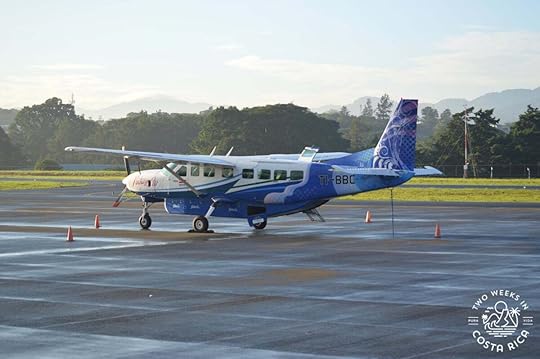
Domestic flights operate from both of Costa Rica’s international airports: SJO near San José and Guanacaste Airport (LIR) in Liberia.
These small planes are most often used to reach remote destinations like Tortuguero on the Caribbean coast, Puerto Jimenez and Drake Bay on the Osa Peninsula, and Santa Teresa, Montezuma, and Tambor on the Nicoya Peninsula.
Airstrips are located all around the country in places like:
Drake Bay and Puerto Jimenez (Osa Peninsula)Tortuguero and Limon (Caribbean coast)Cobano (southern Nicoya Peninsula)Quepos/Manuel Antonio (central Pacific coast)Nosara and Tamarindo (Guanacaste)La Fortuna/Arenal (Northern Highlands)Palmar Sur and Golfito (southern Pacific coast)Most of these are basic airstrips without many amenities for travelers.
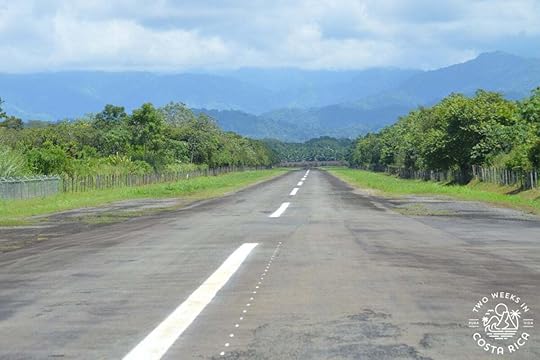 The airstrip in QueposMain Domestic Airlines in Costa Rica
The airstrip in QueposMain Domestic Airlines in Costa RicaIn Costa Rica, the main domestic carriers are SANSA, which has been in operation for many years and has the most routes, and Costa Rica Green Airways, a newer, smaller company with limited routes.
General CostsFlights generally cost $95-160 each way. Prices vary based on destination and season.
Advantages of Domestic FlightsCutting Travel TimeThe most obvious benefit to domestic flights is the dramatic reduction in travel time. What might be a 7-hour drive from San Jose to Puerto Jimenez becomes a 45-minute flight. For travelers with limited time, this can mean an extra day of vacation.
Spectacular ViewsWhen we visited Costa Rica as tourists years ago, before moving here permanently, we flew on small planes several times. We enjoyed the adventure aspect of taking them, but the views from above were also incredible!
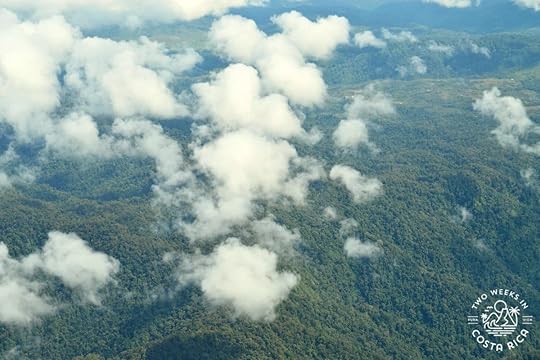 Views on a small plane flight we took years agoAccess to Remote Areas
Views on a small plane flight we took years agoAccess to Remote AreasAnother major benefit of small plane flights is that they make some destinations much more accessible.
Tortuguero on the northern Caribbean coast is one example. No roads go directly to Tortuguero so you need to take a boat or plane to get there. From San Jose, the drive to the boat docks is about 3 hours then it’s another 1.5-hour boat ride to reach the village. You could instead take a small plane directly from San Jose, making the trip just 40 minutes.
Problems with Domestic FlightsDespite these advantages, we no longer recommend domestic flights for several reasons.
Reliability IssuesLast-minute cancellations are common with small plane operators in Costa Rica. Flights are sometimes delayed or canceled because of bad weather or some other reason. Not only is this inconvenient, but it can be very difficult to get a refund if this happens.
Luggage ConstraintsAn issue for some travelers is the luggage restrictions for domestic flights. These are small aircraft and, therefore, can’t hold too much extra weight.
Luggage is generally restricted to 1 checked bag at 30-50 pounds (14-23 kg), depending on carrier, and 1 small carry-on item. In some cases, you can pay more for extra luggage, but only if the plane has the ability to carry the extra weight. In most cases, the passengers are weighed as well to calculate the total payload.
SafetyThe most serious concern that we have with small planes in Costa Rica is safety. The most well-known crash in recent years was in 2017 when a Nature Air flight crashed after takeoff from the airstrip in Punta Islita. All 12 people on board (who were on vacation from the US) were tragically killed.
We also personally know of several other deadly crashes involving small aircraft in Costa Rica, both of major and private carriers. Because of these incidents and our uncertainty about oversight of the industry, we don’t recommend domestic flights at this time.
Alternative: Carefully Plan Your ItineraryInstead of taking domestic flights, we recommend driving or taking a shuttle to your destination.
Often, you can structure your itinerary to break up long drives with strategic overnight stops. For example, when traveling from San Jose to Drake Bay (about a 7-hour journey via car and boat), you could stop in Jaco or Manuel Antonio for a night. This will not only break up the trip but will let you see another area of the country.
Our post Costa Rica Itinerary with Osa Peninsula is a good example of how to do this.
Being strategic with which international airport you use can also help. For example, if you’re planning to visit Santa Teresa on the southern Nicoya Peninsula, you should fly into Liberia, which is closer than San Jose. Then you can structure the rest of your itinerary to make your way back to Liberia or plan to fly out of San Jose and check out towns on the central Pacific coast via the ferry.
Need help structuring your itinerary? Our Itinerary articles are a great starting point. We’ve carefully crafted them to make sure you’re not spending too much time on the road. Or feel free to reach out through our Video Chat Service for personalized help.
ConclusionWhile small planes offer a quick way to reach remote destinations in Costa Rica, the reliability and safety concerns make them difficult to recommend. Driving is the best way to experience the country anyway in our opinion because you have the flexibility to stop and go as you please. Some of our best travel memories in Costa Rica have come from those unexpected stops and discoveries along the way!
Have a question about domestic flights in Costa Rica? Ask us below.Looking for more information to plan your trip? Check out these posts:Costa Rica Transportation Options: This page covers all the major transportation options, including driving, taking a shuttle, or taking the bus.
Safety in Costa Rica: Get general safety information on keeping your valuables and rental car secure plus helpful tips.
Health & Safety: Our Health and Safety articles cover lots of different related topics like drinking water safety and beach safety.
Practical Travel: Learn other travel basics like how to handle money on your trip, what to expect for weather, and lots more.
The post Domestic Flights in Costa Rica: Why We Don’t Recommend Them appeared first on Two Weeks in Costa Rica.
July 25, 2025
Beach Safety in Costa Rica: Rip Currents & Swimming
Two Weeks in Costa Rica |
Costa Rica no doubt has some of the most stunning beaches in the world, but many have powerful rip currents that can be very dangerous. In this post, we’ll give some background on beach safety in Costa Rica, help you identify rip currents, and give a list of safer swimming beaches.

Costa Rica’s beaches vary a lot in terms of safety. Up and down the Pacific and Caribbean coast, you’ll find both beaches with relatively calm water and also many surfing beaches with powerful waves.
Some of the most popular beach destinations in the country like Jaco, Tamarindo, Dominical, Santa Teresa, and Nosara are surfing beaches with big waves and strong currents.
Lifeguards in Costa RicaMost of Costa Rica’s beaches, unfortunately, do not have a lifeguard. The government doesn’t fund them in most areas, leaving it up to local communities.
You will find lifeguards on certain beaches, but the resources are limited. There may be only one or two for a long stretch of beach, or they may be responsible for multiple beaches in one area so can’t cover everywhere. These people do an amazing job, though. We often hear about successful rescues on the beaches near where we live.
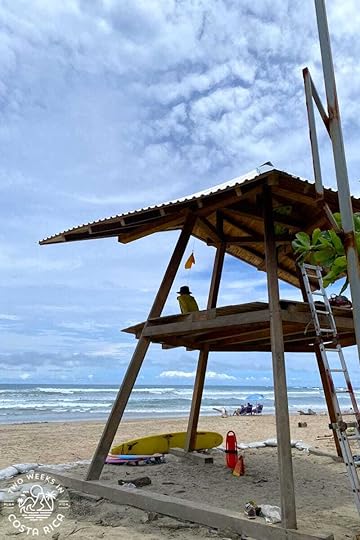 Lifeguard stand at Playa Guiones, Nosara
Lifeguard stand at Playa Guiones, NosaraEvery year in Costa Rica, both tourists and locals still sadly drown at the country’s beaches. Most of those deaths are because of rip currents that they didn’t realize were there.
Staying Safe at Costa Rica’s BeachesFirst, always be mindful of signs warning about rip currents. We have been to hundreds of beaches in Costa Rica, and while not all dangerous beaches have these signs, many do.

Also keep an eye out for flags placed on the beach, warning about dangerous ocean conditions. Lifeguards or the local municipality sometimes put these out. Red flags indicate dangerous conditions and you shouldn’t go in the water. Yellow flags mean that you should use extra caution. Note that many beaches do not have flags at all.
If a beach does have a lifeguard, it’s a good idea to swim near the lifeguard stand. If there’s no lifeguard, try to swim near other people and don’t isolate yourself. We often hear stories of how a nearby surfer or random beach goer helped pull someone out of a dangerous situation. It’s good to have others around!

Finally, if you are nervous at all about current conditions, don’t go out deeper than your waist. You can still have a lot of fun wading or splashing in the shallow waves. That’s what our family does.
 Enjoying the shallow water in NosaraHow to Recognize a Rip Current
Enjoying the shallow water in NosaraHow to Recognize a Rip CurrentA rip current is a powerful channel of water flowing away from shore that pulls you out to sea. Usually, people have no idea that they are swimming in an area with rip currents and are out too deep when they get in trouble. Here is what to look for.
Different colored water (muddy or foamy) flowing away from shoreCalm areas in breaking waves where other areas have whitecapsLines of foam or debrisFeeling a strong pull away from shore, even in knee-deep waterBeing swept parallel to the beach faster than normalRip currents can form quickly and change throughout the day. We have often found that they are the worst when the tide is changing.
 The rip current is noted with the arrow. Photo Credit: Guardavidas Costa Ballena Lifeguards (Dominical Beach)What to Do if Caught in a Rip Current
The rip current is noted with the arrow. Photo Credit: Guardavidas Costa Ballena Lifeguards (Dominical Beach)What to Do if Caught in a Rip CurrentTry not to panic. Do your best to stay calm. Here’s what to do:
DO NOT swim directly back to shore—you’ll exhaust yourselfSwim parallel to the shore until you escape the currentOnce free, swim back to shore at a 45-degree angleIf you can’t swim out, float and wave for help—the current weakens beyond the breakersRemember: Rip currents pull you out, not under. Stay calm and work with the ocean.
Here is a diagram that explains more:

For more information on rip current safety, check out the U.S. Lifesaving Association’s rip current guide.
Safer Swimming BeachesFor safer swimming beaches in Costa Rica, these spots generally offer calmer water. **Always be sure to check current conditions on your visit.**
Guanacaste/Northern Pacific Coast: Playa Potrero, Playa Penca, Playa Hermosa (Guanacaste), Playa Panama, Playa Ocotal, Playa Danta & Playa Dantita, Playa Conchal, Playa Samara, Playa Carrillo
Central Pacific Coast: Playa Mantas and Playa Blanca (north of Jaco), Playa Manuel Antonio (inside the national park), Playa Biesanz
Southern Pacific Coast: Puerto Jimenez’s main beach
Caribbean Coast: Playa Negra near downtown Puerto Viejo (close to town/El Barco)
Even at these “safer” beaches, conditions change quickly with weather, tides, and swells.
If you’re traveling to Costa Rica with kids, also be sure to check out our post on the Best Beaches in Costa Rica for Families.
 Our kids at Playa MantasConclusion
Our kids at Playa MantasConclusionCosta Rica’s beaches are definitely worth experiencing, but respecting the ocean’s power is essential to ensuring a safe visit. Always be mindful about current conditions, ask locals about beach safety, and never swim alone. A little caution ensures your Costa Rica beach memories are nothing but positive.
Have a question about beach safety in Costa Rica? Ask us below.Looking for more information to plan your trip? Check out these posts:Safety Tips for Your Trip to Costa Rica: Practical safety tips, including keeping your valuables secure and staying safe while driving and at vacation rentals.
Costa Rica’s Water: Learn about drinking water safety in different regions of Costa Rica.
Costa Rica and Mosquitoes: Get information on mosquito-borne diseases and tips on avoiding bites.
Health and Safety: Browse our Health and Safety articles for more information on staying safe during your trip.
Practical Travel: Get information on handling money, weather, packing, and more.
The post Beach Safety in Costa Rica: Rip Currents & Swimming appeared first on Two Weeks in Costa Rica.
April 30, 2025
21 Local Tips for Traveling to Costa Rica with Kids
Two Weeks in Costa Rica |
Last Updated: June 6, 2025
Overwhelmed by your upcoming family trip to Costa Rica? There is so much to think about! As a family living in Costa Rica since 2013 with two kids (now 9 and 6), we are here to put your mind at ease. In this post, we’ll share some local tips about traveling to Costa Rica with kids that you won’t find in typical travel guides.
This post is part of our Costa Rica with Kids hub, which includes detailed activity guides, hotel recommendations, and family itineraries.
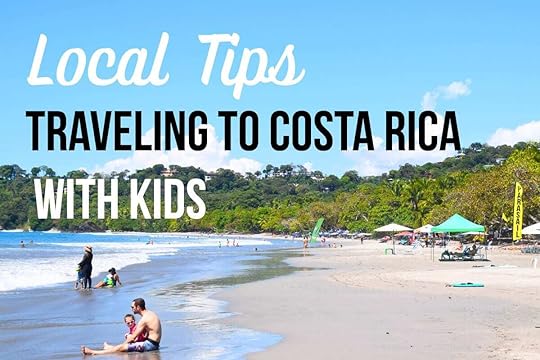
A big relief for most parents is that restaurants in tourist areas usually have kid-friendly menu options.
Standard kids’ offerings include chicken or fish fingers with fries, plain pasta, a burger, rice and beans, and quesadillas.
 Fun kid’s meal at a small restaurant on the Caribbean coast
Fun kid’s meal at a small restaurant on the Caribbean coastSome restaurants won’t have a separate menu so it’s good to have backup options.
Traditional Costa Rican dishes like casados work well for many kids. Casados are usually served at lunchtime. They have a variety of different foods, but typically include rice, beans, fried plantains, side salads, and a protein like chicken, fish, or beef.
Rice dishes like arroz con pollo (rice with chicken) or arroz con camarones (rice with shrimp) are also a hit with some kids. These staple dishes are always served with French fries and a side salad.
For breakfast, eggs are a good option. Many kids also enjoy fresh local cheeses like Turrialba. This is a soft, bland cheese that both our kids love.
If you’re traveling with a baby or toddler, you could just get them a side of rice and beans or platanos (sweet fried plantains). This is what we did when our kids were young.
Restaurants usually have highchairs. They’re often cute wooden chairs that are handcrafted in Costa Rica.
 Rice and beans with eggs and a tortilla for our youngest2. Speaking Spanish
Rice and beans with eggs and a tortilla for our youngest2. Speaking Spanish While most people working in tourism speak at least some English, a few basic phrases go a long way if you don’t speak Spanish.
Locals absolutely light up when kids try to speak Spanish, even just “hola” and “gracias.” Kids often pick up words faster than parents too! Don’t worry about perfect pronunciation. Costa Ricans are patient and appreciate any effort.
One phrase that’s helpful: “¿Habla inglés?” (Do you speak English?). This saves awkward moments when you’re not sure.
If you get stuck, most Costa Ricans are incredibly helpful and will find someone who speaks English or use gestures to communicate. We’ve seen this countless times—it’s part of that friendly culture we love here.
For more helpful phrases, see our Simple Spanish for Costa Rica post.
3. Drinking WaterYou can drink tap water and ice in most parts of Costa Rica without a worry. There are, however, some exceptions. We have lived in towns where you want to avoid tap water.
Places where bottled or filtered water is recommended include Esterillos, Bejuco, Puerto Viejo de Talamanca, Cahuita, and parts of northern Guanacaste (Tamarindo, Playa Grande, Flamingo, etc.).
Our drinking water safety post has more information.
4. SmoothiesMake sure your kids try a fresh fruit smoothie (batido)! Costa Rica has so many amazing tropical fruits like pineapple, papaya, mango, and even soursop (guanabana). Our kids love these while waiting for food.
Tip: You can have smoothies made with just ice or ask for them with milk (con leche) to thicken it up like a milkshake.
 Fresh pineapple smoothie!5. Healthy Snacks
Fresh pineapple smoothie!5. Healthy Snacks While you may be able to grab an organic oat and fruit granola bar at any checkout where you live, in Costa Rica that is not the case.
Most snacks are unhealthy chips, cookies, and crackers. If you look a little harder, you can find some better options, though.
Nuts, fresh fruits, and specialty foods without all the additives are often hiding in the larger grocery stores somewhere. A couple of good brands to look for are Seed or Nutrisnacks. These are Costa Rican companies that make healthier snack options.
Still, you might want to pack some of your own snacks for the trip. Here’s a link to our post on what kinds of foods you can bring into Costa Rica.
6. Ice Cream, Granizados, and ChurchillsOn the opposite end of the spectrum are these sweet treats.
Ice cream shops are popular all around the country because the locals love it. The biggest and most commercial is the chain, Pops. But there are smaller ones in most towns too.
For something unique, beach vendors often sell granizados (pronounced Gran-E-Saados) or Churchills. These are shaved ice treats with sweet syrup, condensed and powdered milk, and sometimes extra toppings. The Churchill is basically a granizado with a scoop of ice cream on top plus some other embellishments.
Tip: The most common flavor of syrup for the shaved ice is called cola. It tastes nothing like Coca-Cola and is sweet and red.
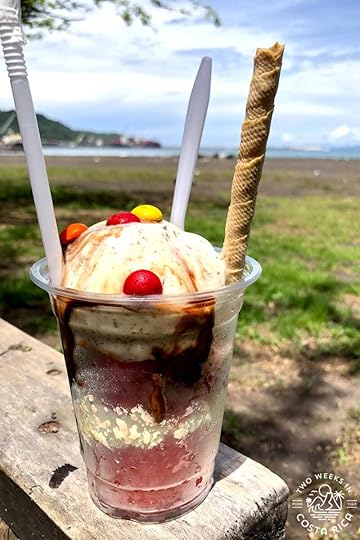 A Granizado in Caldera – this is a popular spot for getting these treats7. Wildlife Viewing & Keeping Kids EngagedSpotting Wildlife
A Granizado in Caldera – this is a popular spot for getting these treats7. Wildlife Viewing & Keeping Kids EngagedSpotting WildlifeHere’s a good tip for spotting wildlife: If you are on a trail without a lot of other people around, walk slowly and quietly. Often wildlife like monkeys or birds will freeze up when they hear a noisy group coming and you’ll miss them.
We’ve watched people walk briskly past us and go right under a family of howler monkeys in the trees, without even noticing them.
If you are walking quietly down the trail, you may hear the monkeys before they hear you. That will make them easy to spot!
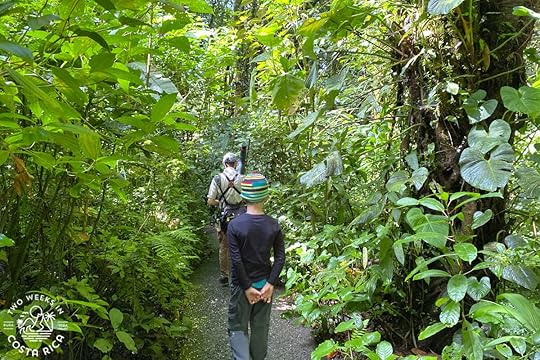 Looking for wildlife in MonteverdeKid Gear for the Trail
Looking for wildlife in MonteverdeKid Gear for the TrailWe do a lot of hiking and nature tours with our kids and have learned to bring some fun things to help keep them engaged.
A kid-friendly camera and wildlife identification guides are two essentials we always have. Our youngest loves taking pictures of everything he sees. The fold-out wildlife guides help both kids spot and identify animals. They’re laminated too so are pretty indestructible.
@media (max-width: 767px) {<br /> .mobile-center-text {<br /> text-align: center !important;<br /> }<br />}<br />

Free Tour Booking Service!
Need help booking tours for your family’s trip? We book tours all around Costa Rica. Booking through us doesn’t cost extra and helps support our website.
View tours in major destinations
Learn more about our travel agency
This is a great money-saving tip for families: most tour companies offer decent discounts for kids.
Children ages 5-11 usually get around 30-50% off the adult rate (it varies by tour company). Kids under 5 are typically free. A few tours offer special student rates for teenagers as well. These discounts can add up when you’re doing multiple activities during your trip.
9. Interacting with AnimalsA lot of people ask us, “Where can I hold a sloth in Costa Rica?”
The truth is that holding a sloth or any other animal is really bad for them. Feeding them is bad too. It gets them used to humans and changes their behavior in the wild.
Unfortunately, other countries allow this, but in Costa Rica, it is strictly prohibited. Costa Rica even has a campaign against animal selfies (you with an animal close in the background). It’s for the benefit of the animals, which we can all appreciate.
Read our post, Sloth Tours in Costa Rica: What’s Ethical?, for some recommendations on how to see these cool creatures up close with minimal impact.
 A sloth we saw at the Sloth Sanctuary in Monteverde10. Mosquitoes and Other Bugs
A sloth we saw at the Sloth Sanctuary in Monteverde10. Mosquitoes and Other BugsInsects are part of life in the tropics. Mosquitoes can be found year-round, but especially during the rainy season (May through November). Usually they aren’t too bad, but it depends on when and where you’re visiting. We find them to be the worst at dawn and dusk.
While mosquito-borne diseases like dengue do exist in Costa Rica, it’s not likely that you’ll contract anything during your short visit. Thankfully, no one in our family has gotten dengue or any other mosquito-borne disease in our 10+ years in Costa Rica.
What we do to avoid bites is wear lightweight long pants for jungle hikes whenever possible and insect repellent if we wear shorts. The repellents we use the most are Picaridin and family DEET.
Here are some links to a few of our articles with more info:
Costa Rica and Mosquitoes: Tips to Prevent Zika, Dengue, and More
Bugs, Spiders, and Snakes in Costa Rica: What to Expect
11. Sun ProtectionSun protection is one of the most important things to keep in mind when visiting Costa Rica with kids. Costa Rica is very close to the equator so the sun is intense year-round, even on cloudy days.
Pack rash guards (long-sleeved not short sleeved) for the ocean and pool, hats, and plenty of reef-safe sunscreen. These Coolibar hats are what we have been using for our kids for years. We use these wide-brim hats for hiking.
Although you can buy sunscreen in Costa Rica, the options are more limited (especially for natural). It’s also more expensive.
See our Packing List for more tips.
 Our youngest son in his water hat12. Beaches
Our youngest son in his water hat12. BeachesCosta Rica’s beaches vary a lot as far as safety and swimming conditions so choosing the right ones is essential. While some are coves with gentle water, perfect for young swimmers, others are long stretches of sand with powerful breaks.
On most surfing beaches, rip tides are a concern. Splashing and swimming in the shallow water can be fine but be sure to teach your kids about the dangers of rip currents so they don’t go out too far. You will see lifeguards at some beaches in Costa Rica, but because they are usually not government-funded, they’re not everywhere.
Guanacaste Province on the northern Pacific coast offers some of the most family-friendly swimming beaches, but there are good spots in other regions too.
Before planning your beach days, be sure to check our detailed guide to the Best Beaches for Families in Costa Rica.
 The beautiful, but turbulent, Playa Montezuma13. Costa Rica’s Sand
The beautiful, but turbulent, Playa Montezuma13. Costa Rica’s Sand Something most people don’t talk about is how fine Costa Rica’s sand is.
The sand grains on most beaches are very tiny and get stuck in swimwear easily. This can be a pain to wash out.
We find agitating swimsuits in a bucket of water or the sink is the best way to get the sand out. If that’s not possible, try letting them dry completely and then shaking vigorously outside!
14. The Stingray ShuffleNo one in our family has been stung by a stingray in Costa Rica but you should know that they are around.
One thing the local surfers have taught us is the “stingray shuffle.”
Basically, as you are walking through the water, shuffle your feet in the sand as you go. This scares the stingrays away. If a sting does happen, don’t worry, these are painful but not poisonous.
Our Jellyfish and Stingrays in Costa Rica post has more info.
15. SouvenirsIf your kids are like ours, we can’t step foot in a gift shop without breaking out the wallet for trinkets, new apparel, or the “softest teddy” they’ve ever felt.
Souvenir shops in Costa Rica are usually good about having locally handcrafted jewelry, wood carvings, and artwork mixed in with the more commercial hats and T-shirts.
Definitely shop around if you aren’t in a hurry. We’ve found prices are all over the place with souvenir shops, even for the exact same items.
 A giant souvenir store in La Fortuna
A giant souvenir store in La FortunaNote: An important thing to know for kids who love collecting is that you can’t keep shells, seeds, or volcanic rocks. Every year, thousands of these treasures are confiscated at Costa Rica’s airports. There are even some beaches where, sadly, you can barely find seashells anymore.
16. MoneyThe easiest way to pay for things in Costa Rica is with a credit card. They’re accepted almost everywhere now. Hotels, restaurants, tour companies, and most small businesses take them.
That said, you’ll still want to keep some cash on hand. Sometimes you’ll need it for tips, street vendors, farmers markets, and the occasional small soda (local restaurant) that’s cash-only.
ATMs are everywhere in tourist destinations but can be harder to find in certain towns (e.g., Drake Bay and Tortuguero). Be sure to get cash in advance if you’re visiting these remote destinations.
If you do use cash, paying in colones (the local currency) usually gets you a better exchange rate than US dollars, especially with small vendors. Keep small bills (1,000 and 2,000 colon bills) handy for tips and small purchases.
For lots more information, read our post, Money Matters: Currency, Exchanging Money, and Tipping in Costa Rica.
 Costa Rica’s beautiful money17. Wi-Fi
Costa Rica’s beautiful money17. Wi-FiInternet and Wi-Fi coverage in Costa Rica is fairly good, so if you have kids or teens with devices, you should be all set.
High-speed fiber optic or cable internet is available in all but the most remote areas. Most hotels and vacation rentals offer free Wi-Fi too. The speeds are generally fast enough for streaming videos, video calls, and uploading photos.
Restaurants and cafes usually have Wi-Fi, but not always. Sometimes you have to ask for the password (clave). Don’t be surprised if smaller, local sodas (restaurants) don’t have Internet.
One thing we’ve learned: if you’re heading to very remote eco-lodges or staying in places like Drake Bay or deep in the rainforest, Wi-Fi can be spotty or nonexistent. That’s actually part of the charm for some families who want to truly disconnect!
 This beach town on the Osa Peninsula was off the grid!18. Long Car Rides & Staying Connected
This beach town on the Osa Peninsula was off the grid!18. Long Car Rides & Staying ConnectedFor travel between destinations, we recommend having some downloaded movies or offline games available on your kids’ devices. Although the scenery outside will be completely new and different, they may still get bored on a long drive.
 The scenic road to the Rio Celeste area
The scenic road to the Rio Celeste areaTo get connected on the road, you can use your existing phone plan from your home country. Often you just need to pay an additional daily fee for travel abroad. Or, if you have an unlocked phone, you could get a local SIM card. Here’s a link to our post on Getting a SIM Card for Costa Rica.
Costa Rica does have dead zones due to its mountainous terrain, but you should have a good signal most of the time.
Something else worth mentioning is that basically all the locals use WhatsApp. It’s one of the best ways to communicate here.
19. ChargersCosta Rica uses the same style electrical outlet as the US and Canada (Type A and B plugs; 120 V).
Even so, sometimes hotel rooms or vacation rental houses don’t have many places to plug in and recharge. Our family is always fighting for charging cords at the end of a long, battery-draining day.
Be sure to bring plenty of phone and tablet charging cords with you. Sometimes extra-long ones are helpful too, especially if your kids need to recharge while they are still using their device.
20. Car SeatsCar seats are required by law in Costa Rica for kids ages 12 and under up to a certain size. Our Car Seats in Costa Rica post has the specific requirements.
Rental car and shuttle transportation companies can both provide them. We have a special rental car discount and car seats are free for our readers.
It’s important to note that they are not necessary for tour transfers. So tour companies usually don’t offer them.
If you’d like to use a car seat, you can bring your own and install it in the van (this is what we do). Sometimes it’s easier to just meet the tour guide at the starting location if you are renting a car to avoid the issue altogether.
21. Early Nights and Early MorningsOur last tip is to be ready for early nights and early mornings.
In Costa Rica, the sun sets around 6:00 p.m. year-round. While some busier beach towns have nightlife, ecotourism towns and more remote spots get quiet by around 9:00 p.m.
A lot of families get in a rhythm of going to bed early after a busy day and waking up early for the next adventure.
If you have light sleepers in your family, also know that the sun rises by 5:30 a.m. All the noisy tropical birds, monkeys, and occasional motorcycle or big truck start their day at that time too. A sound machine can help with this (our family uses the Dreamegg).
 Sunset in Playa FlamingoConclusion
Sunset in Playa FlamingoConclusionWe hope that these local insights help make your Costa Rica family adventure a lot smoother and more enjoyable.
For comprehensive trip planning guidance, destinations, and itineraries for your family’s vacation, don’t forget to check out our Costa Rica with Kids hub.
Some of the links in this post are connected to affiliate programs we have joined. As an Amazon Associate we earn from qualifying purchases.
FAQs About Traveling to Costa Rica with Kids Is the Caribbean or Pacific coast better for families?Both coasts have gorgeous beaches and abundant wildlife, but the Pacific coast is generally our recommendation for families, especially for a first-time visit. The Pacific side has more developed tourism infrastructure, a wider range of family-friendly accommodations, and overall lower crime rates.
The Caribbean has its own unique charm and cultural vibe, but the Pacific offers more reliable weather patterns and easier access to other popular destinations.
Are there itinerary options that don’t require a lot of driving?Yes! Costa Rica’s mountainous terrain can make for some longer drives between destinations, which isn’t always ideal with kids. We recommend focusing on just two destinations for a seven-day trip and choosing locations that are closer together.
Our post on 2 Itineraries that Limit Drive Time gives you options that minimize time in the car while still allowing you to experience the best of Costa Rica.
What is the best Costa Rica itinerary with kids?There are so many good options!
For a sample family itinerary, read our post, Costa Rica with Kids: A 10-Day Itinerary.
If you’d like personalized help with your family’s planning, feel free to reach out through our Video Chat Service to schedule a call. We can help you with an itinerary and recommend specific hotels and activities.
What is the best time of year to visit Costa Rica?For families, the dry season (December through April) offers the most reliable weather, though it’s also the busiest and most expensive time.
Early rainy season (May through end of July) is a great time to visit, with lower prices, fewer crowds, and typically just afternoon/evening showers that won’t disrupt most of your activities.
Do I need a notarized letter to travel with a child to Costa Rica?There are no specific requirements on this, but if only one parent is traveling with a child, it’s a good idea to get a notarized letter of consent from the other parent. This can help avoid potential questions or delays at immigration. While many families travel without issues, having this documentation provides peace of mind.
{"@context":"https:\/\/schema.org","@type":"FAQPage","mainEntity":[{"@type":"Question","name":"Is the Caribbean or Pacific coast better for families?","acceptedAnswer":{"@type":"Answer","text":"<p>Both coasts have gorgeous beaches and abundant wildlife, but the Pacific coast is generally our recommendation for families, especially for a first-time visit. The Pacific side has more developed tourism infrastructure, a wider range of family-friendly accommodations, and overall lower crime rates.<\/p><p>The\u00a0<a href=\"https:\/\/www.twoweeksincostarica.com\/costa-ri... its own unique charm and cultural vibe, but the Pacific offers more reliable weather patterns and easier access to other popular destinations.<\/p>"}},{"@type":"Question","name":"Are there itinerary options that don\u2019t require a lot of driving?","acceptedAnswer":{"@type":"Answer","text":"<p>Yes! Costa Rica\u2019s mountainous terrain can make for some longer drives between destinations, which isn\u2019t always ideal with kids. We recommend focusing on just two destinations for a seven-day trip and choosing locations that are closer together.<\/p><p>Our post on\u00a0<a href=\"https:\/\/www.twoweeksincostarica.com\/costa-ri... Itineraries that Limit Drive Time<\/a>\u00a0gives you options that minimize time in the car while still allowing you to experience the best of Costa Rica.<\/p>"}},{"@type":"Question","name":"What is the best Costa Rica itinerary with kids?","acceptedAnswer":{"@type":"Answer","text":"<p>There are so many good options!<\/p><p>For a sample family itinerary, read our post,\u00a0<a href=\"https:\/\/www.twoweeksincostarica.com\/family-i... Rica with Kids: A 10-Day Itinerary<\/a>.<\/p><p>If you\u2019d like personalized help with your family\u2019s planning, feel free to reach out through our\u00a0<a href=\"https:\/\/www.twoweeksincostarica.com\/video-ch... Chat Service<\/a>\u00a0to schedule a call. We can help you with an itinerary and recommend specific hotels and activities.<\/p>"}},{"@type":"Question","name":"What is the best time of year to visit Costa Rica?","acceptedAnswer":{"@type":"Answer","text":"<p>For families, the dry season (December through April) offers the most reliable weather, though it\u2019s also the busiest and most expensive time.<\/p><p>Early rainy season (May through end of July) is a great time to visit, with lower prices, fewer crowds, and typically just afternoon\/evening showers that won\u2019t disrupt most of your activities.<\/p>"}},{"@type":"Question","name":"Do I need a notarized letter to travel with a child to Costa Rica?","acceptedAnswer":{"@type":"Answer","text":"<p>There are no specific requirements on this, but if only one parent is traveling with a child, it\u2019s a good idea to get a notarized letter of consent from the other parent. This can help avoid potential questions or delays at immigration. While many families travel without issues, having this documentation provides peace of mind.<\/p>"}}]} Have a question about traveling to Costa Rica with kids? Ask us below!Looking for more information to plan your trip? Check out these posts:Transportation Options in Costa Rica: Car, Shuttle, Uber & More – Learn about all the options for getting around.
Naturalist Guides in Costa Rica: When You Need Them and How to Find One – This will help you decide when it’s worth getting a guide.
Costa Rica Hotel Guides: Get reviews of hotels in popular destinations.
The post 21 Local Tips for Traveling to Costa Rica with Kids appeared first on Two Weeks in Costa Rica.
15 Things to Know About Traveling to Costa Rica with Kids
Two Weeks in Costa Rica |
Wondering if Costa Rica is a good destination to visit with kids? As a family living here since 2013 with two kids (now 9 and 6) born in Costa Rica, we can definitely say, yes! We’ve explored beaches, rainforests, and volcanoes with our kids all around the country and know what works for families.
In this post, we’ll share why Costa Rica is great for kids and give you practical tips about transportation, kid-friendly activities, and accommodations. We’ll also share local insights about traveling to Costa Rica with kids from our years of living here that you won’t find in typical travel guides.

Costa Rica is a natural playground with a diverse environment all within one small country. Your kids will be able to experience rainforests, volcanoes, cloud forests, and beaches during a single vacation!
The wildlife viewing is really amazing here and often happens without much effort – monkeys swinging in trees above you, toucans flying overhead, and even sloths hanging out outside your window. Nature is very accessible, with well-maintained trails and easy hikes in many areas.
 A white-faced monkey we saw at a beach in Guanacaste
A white-faced monkey we saw at a beach in GuanacasteWe have lots of articles on our website with things to do in Costa Rica with kids, but here are some of our favorites to give you an idea:
Wildlife viewing – Spot monkeys, sloths, toucans, and frogs on a guided hike, night tour, or boat tour – even from your hotel in some places.Hanging bridges and hiking – Walk through the rainforest canopy on suspension bridges or explore volcano trails with amazing views.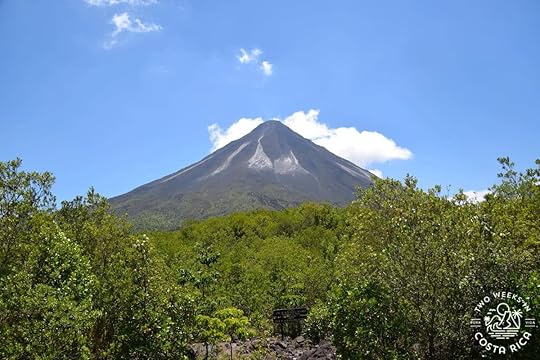 Arenal Volcano near La Fortuna – one of Costa Rica’s top attractionsAdventure activities – Try family-friendly ziplining, whitewater rafting, or even waterfall rappelling.Beach days – Swim, body surf, or take surf lessons – our kids started surfing around age 5 and love it!Waterfall visits – Cool off in one of the country’s many natural swimming holes.Agricultural tours – Learn how chocolate and coffee are made (with tastings!). We started doing these tours when our kids were toddlers. They’re very hands-on.
Arenal Volcano near La Fortuna – one of Costa Rica’s top attractionsAdventure activities – Try family-friendly ziplining, whitewater rafting, or even waterfall rappelling.Beach days – Swim, body surf, or take surf lessons – our kids started surfing around age 5 and love it!Waterfall visits – Cool off in one of the country’s many natural swimming holes.Agricultural tours – Learn how chocolate and coffee are made (with tastings!). We started doing these tours when our kids were toddlers. They’re very hands-on. Our oldest son taking a surf lesson in Jaco2. The locals are very friendly and welcoming
Our oldest son taking a surf lesson in Jaco2. The locals are very friendly and welcomingOne of the best things about Costa Rica for families is how genuinely welcoming locals are to children.
Costa Ricans (Ticos) truly value family and go out of their way to make kids feel special. Don’t be surprised when a restaurant server or shop owner interacts with your kids or offers them a treat.
Tour guides are also usually great with kids, going the extra mile to make sure children are engaged and having fun.

Free Booking Service
If you need help booking any activities for your family’s trip, feel free to reach out through our Tours page. We book tours all around Costa Rica. Booking through us doesn’t cost extra and helps support our website.
View tours all around Costa Rica
Learn more about our travel agency
If you’re concerned about safety when traveling with your kids, you’ll be glad to know that Costa Rica is generally very safe for family travel. It’s considered one of the safest countries in Central America, with a stable democracy and no army.
Most crime is petty theft that you can avoid with basic precautions – like not leaving anything inside your rental car or leaving valuables unattended at the beach. For more detailed safety information, check out our Safety Tips post.
4. The water is safe (almost everywhere)You can drink tap water in most parts of Costa Rica without a worry. There are, however, some exceptions. We have lived in towns where you want to avoid tap water.
Places where bottled or filtered water is recommended include Esterillos, Bejuco, Puerto Viejo de Talamanca, Cahuita, and parts of northern Guanacaste (e.g., Tamarindo, Playa Grande) during dry season (January-April) when water is scarce.
For more information, read our post, Costa Rica’s Tap Water: Safe to Drink or Buy Bottled?
5. There are lots of options for family-friendly hotelsCosta Rica has so many options for family-friendly destinations and accommodations. You’ll find unique treehouses and glamping, ecolodges with trails right on the property, farm stays, resorts with all the amenities, and everything in between.
Most nicer hotels have swimming pools, reliable WiFi, and TVs for downtime. Most properties are smaller and family-owned rather than large chain resorts.
The hot spring resorts in La Fortuna (like Arenal Springs Resort) are particularly great for families.
 Our kids enjoying the hot springs in La Fortuna
Our kids enjoying the hot springs in La FortunaWhile large all-inclusive resorts are available, these don’t offer much for local culture. Since Costa Rica is safe, it’s better to stay at a regular hotel to experience what the country is all about.
For specific destinations that we recommend for families, see the FAQs section below.
6. You’ll have internet (almost) everywhereInternet and phone in Costa Rica has greatly improved over the last 10 years so if you have teenagers with devices, you should be all set.
High-speed internet is available in all but the most remote areas. Most hotels and vacation rentals offer free Wifi. Speeds can vary so if you need it for work, be sure to ask the property directly.
Restaurants and cafes usually have Wifi, but not always.
Although there are some dead zones due to the country’s mountainous terrain, you’ll have a good signal most of the time when you’re on the road.
For phone and Internet, you can use your existing phone plan from your home country. Often there’s an additional daily fee. Or, if you have an unlocked phone, you could get a local SIM card. Here’s a link to our post on Getting a SIM Card for Costa Rica.
Important Considerations About Traveling to Costa Rica with Kids7. Beaches differ a lotCosta Rica’s beaches vary a lot as far as safety and swimming conditions so choosing the right ones is essential. While some have gentle water perfect for young swimmers, others have powerful waves better for surfers.
 The beautiful, but turbulent, Playa Montezuma
The beautiful, but turbulent, Playa MontezumaGuanacaste Province on the northern Pacific coast offers some of the most family-friendly swimming beaches.
Before planning your beach days, be sure to check our detailed guide to the Best Beaches for Families in Costa Rica.
 Samara Beach’s small waves8. There are mosquitoes and other bugs
Samara Beach’s small waves8. There are mosquitoes and other bugsInsects are part of life in the tropics. Mosquitoes can be found year-round, but especially during the rainy season (May through November). Usually they aren’t too bad, but it depends on when and where you’re visiting.
While mosquito-borne diseases like dengue do exist in Costa Rica, it’s not likely that you’ll contract anything during your short visit. Thankfully, no one in our family has gotten dengue or any other mosquito-borne disease in our 10+ years living in Costa Rica.
What we do to avoid bites is wear lightweight long pants for jungle hikes whenever possible and insect repellent if we wear shorts.
Here are some links to a few of our articles with more info:
Costa Rica and Mosquitoes: Tips to Prevent Zika, Dengue, and More
Bugs, Spiders, and Snakes in Costa Rica: What to Expect
9. You’ll need to be prepared for the sunSun protection is one of the most important things to keep in mind when visiting Costa Rica with kids. And it’s what we see parents most confused about.
Costa Rica is very close to the equator so the sun is intense year-round, even on cloudy days.
Pack rash guards (long-sleeved not short sleeved) for the ocean and pool, hats, and plenty of reef-safe sunscreen. These Coolibar hats are what we have been using for our kids for the pool/beach for years and we use these wide-brim hats for hiking.
 Our youngest son in his water hat
Our youngest son in his water hatAlthough you can buy sunscreen in Costa Rica, the options are more limited (especially for natural) and it’s more expensive. We love Think Baby for our family. See our Packing List for more tips.
More Specific Info & Local Tips10. Most families rent a car (but you can also take shuttles)Rental CarFor most families visiting Costa Rica, renting a car makes the most sense. It gives you the flexibility to stop when the kids need a bathroom break, feel carsick, or if you want to visit an attraction between destinations. You can pack all those extra things you need with kids and come and go at your own pace.
Many of our clients and readers find that having their own vehicle makes for a much more relaxed vacation.
If you’re planning to rent a car, be sure to check out our exclusive rental car discount . Our readers get 10% off plus free car seats.
 The scenic road to the Rio Celeste areaShuttles
The scenic road to the Rio Celeste areaShuttlesIf you’re nervous to drive, lots of families choose to take private shuttles. That way, they don’t have to worry about any driving logistics and can just sit back and enjoy the ride.
Shared and private shuttles are available, but most families opt for private shuttles because they’re more convenient. These go door to door from your accommodations or the airport at a time you choose and are for only your family.
We book shuttle transfers all around Costa Rica through a small network of reliable companies that we have been working with for many years. Contact us through our Private Shuttle Booking page if you’d like any help. Learn more about our travel agency.
11. Family-friendly accommodation and dining are readily availableMost hotels and restaurants throughout Costa Rica are well-equipped for kids.
HotelsMost hotels have portable cribs if you’re traveling with a baby or toddler. Just be sure to request one in advance.
Almost all hotels include a good breakfast, which is really convenient for parents.
Restaurants and FoodRestaurants usually have highchairs for young children. They’re often super cute wooden chairs that are handcrafted in Costa Rica.
Most restaurants in tourist areas have kid-friendly menu options, though they’re usually simpler than what you might be used to back home.
Standard kids’ offerings include chicken or fish fingers with fries, plain pasta, rice and beans, and quesadillas. Traditional Costa Rican dishes like casados (rice, beans, plantains, and a protein) work well for many kids. Sometimes we have just gotten our kids a side of rice and beans with platanos (sweet fried plantains) when they were young.
 Fun kid’s meal at a small restaurant on the Caribbean coast
Fun kid’s meal at a small restaurant on the Caribbean coastIn more remote areas, dedicated kids’ menus are less common, but restaurants are almost always happy to accommodate.
Make sure your kids try a fresh fruit smoothie (batido). Costa Rica has so many amazing tropical fruits like pineapple, papaya, mango, and even soursop (guanabana). Our kids love these while waiting for food.
 Fresh pineapple smoothie!12. Vacation rentals can give you extra space and comfort
Fresh pineapple smoothie!12. Vacation rentals can give you extra space and comfortIf you prefer some space from the kids, vacation rentals can be a great option. Hotels with 2-bedroom suites are hard to find here, but luckily, Costa Rica has tons of options for full houses on sites like Airbnb and VRBO.
Our family stays in vacation rentals regularly when traveling – having a living room where adults can hang out after the kids go to bed is a huge plus!
Check out our post on Vacation Rentals for more advice and some important safety tips.
 A 2-bedroom Airbnb we stayed at in Montezuma13. Kids usually get a discount on tours
A 2-bedroom Airbnb we stayed at in Montezuma13. Kids usually get a discount on toursHere’s something that makes family travel in Costa Rica more affordable – most tour companies offer decent discounts for kids!
Children ages 5-11 usually get around 30-50% off the adult rate (it varies by tour company). Kids under 5 are typically free. A few tours offer special student rates for teenagers as well. These discounts can add up when you’re doing multiple activities during your trip.
14. Car seats are not provided for toursAlthough car seats are required by law in Costa Rica (see the FAQs below), they are not necessary for tour transfers, so tour companies usually don’t provide them.
If you’d like to use a car seat, you can bring your own and install it in the van (this is what we do). Sometimes it’s easier to just meet the tour guide at the starting location to avoid the issue altogether. If you rent a car with the discount mentioned above, you can get free car seats.
15. Traveling with a baby in Costa Rica is totally possibleTraveling with babies or toddlers in Costa Rica requires some extra planning, but it’s definitely manageable. We traveled a lot with both of our kids when they were babies—doing hikes and tours even at three months old!
 Hiking to the Rio Celeste Waterfall when our son was a baby – we even got in a nap!
Hiking to the Rio Celeste Waterfall when our son was a baby – we even got in a nap!Here is a sample of some of the many options for things to do with babies:
Wildlife viewing: Costa Rica has lots of easy nature walks and many lodges have wildlife right on the property so you can enjoy nature without a big excursion.
Beach days: Beaches with calm water like Playa Samara or Playa Hermosa are perfect for introducing babies to the ocean. Morning visits avoid the mid-day heat.
 Playa Hermosa is a great destination for families with kids of all ages
Playa Hermosa is a great destination for families with kids of all agesHot springs: In La Fortuna, many hot spring resorts have shallow, cooler pools where babies can splash around.
Short guided walks: With a good baby carrier, you can enjoy guided nature walks where you’ll spot wildlife (private tours are best so the guide can accommodate your pace).
Chocolate and coffee tours: These tours are very hand-on and casual. They’re also shorter so work well with babies.
For more information on baby travel, read our complete post, Traveling with a Baby in Costa Rica.
Also be sure to check out our Baby Packing List for Costa Rica.
 Doing an easy hanging bridges hike with our youngestConclusion
Doing an easy hanging bridges hike with our youngestConclusionCosta Rica offers families a great mix of nature, adventure, and relaxation. From spotting wildlife to exploring beaches and rainforests, there are plenty of opportunities for kids to experience nature. The country’s family-friendly culture, strong safety record, and variety of accommodations make it ideal for travelers with kids of all ages. Whether this is your first international trip with kids or you’re experienced travelers, Costa Rica has something special to offer your family.
Some of the links in this post are connected to affiliate programs we have joined. As an Amazon Associate we earn from qualifying purchases.
FAQs About Traveling to Costa Rica with Kids Is the Caribbean or Pacific coast better for families?Both coasts have gorgeous beaches and abundant wildlife, but the Pacific coast is generally our recommendation for families, especially for a first-time visit. The Pacific side has more developed tourism infrastructure, a wider range of family-friendly accommodations, and overall lower crime rates.
The Caribbean has its own unique charm and cultural vibe, but the Pacific offers more reliable weather patterns and easier access to other popular destinations.
What are some family-friendly destinations in Costa Rica?Costa Rica has several destinations that are particularly good for families. These have a nice balance of activities and family-friendly accommodations and are fairly easy to access. Here are our top recommendations:
La Fortuna : One of the best spots for families. Lush rainforest, abundant wildlife, and attractions like Arenal Volcano, hot springs, and many activities good for kids and teens. Manuel Antonio : Easy wildlife viewing in the national park and all around town, plus beautiful beaches for swimming. Monteverde : The cloud forest is magical for children, with misty hanging bridges and wildlife exhibits like butterfly gardens and sloth sanctuaries. Samara : A relaxed beach town with smaller waves and just enough to do with kids. Tamarindo : Livelier destination that’s better for families with teens; great surfing and tons of restaurants. Are there itinerary options that don’t require a lot of driving?Yes! Costa Rica’s mountainous terrain can make for some longer drives between destinations, which isn’t always ideal with kids. We recommend focusing on just two destinations for a 7-day trip and choosing locations that are closer together.
Our post on 2 Itineraries that Limit Drive Time gives you options that minimize time in the car while still allowing you to experience the best of Costa Rica.
What is the best Costa Rica itinerary with kids?There are so many good options!
For a sample family itinerary, read our post, Costa Rica with Kids: A 10-Day Itinerary.
For more general tips on choosing an airport, destinations, and hotels, check out our post, Costa Rica with Kids: Essential Planning Tips.
If you’d like personalized help with your family’s planning, feel free to reach out through our Video Chat Service to schedule a call. We can help you with an itinerary and recommend specific hotels and activities.
What is the best time of year to visit Costa Rica?For families, the dry season (December through April) offers the most reliable weather, though it’s also the busiest and most expensive time.
Early rainy season (May through end of July) is a great time to visit, with lower prices, fewer crowds, and typically just afternoon/evening showers that won’t disrupt most of your activities.
What are Costa Rica’s car seat requirements?Car seats are required in Costa Rica for children, though enforcement really varies throughout the country.
By law in Costa Rica, car seats or booster seats are mandatory for kids 12 and under, up to a certain size. For the specific requirements, see our Car Seats in Costa Rica post.
Do I need a notarized letter to travel with a child to Costa Rica?There are no specific requirements on this, but if only one parent is traveling with a child, it’s a good idea to get a notarized letter of consent from the other parent. This can help avoid potential questions or delays at immigration. While many families travel without issues, having this documentation provides peace of mind.
{"@context":"https:\/\/schema.org","@type":"FAQPage","mainEntity":[{"@type":"Question","name":"Is the Caribbean or Pacific coast better for families?","acceptedAnswer":{"@type":"Answer","text":"<p>Both coasts have gorgeous beaches and abundant wildlife, but the Pacific coast is generally our recommendation for families, especially for a first-time visit. The Pacific side has more developed tourism infrastructure, a wider range of family-friendly accommodations, and overall lower crime rates.<\/p><p>The\u00a0<a href=\"https:\/\/www.twoweeksincostarica.com\/costa-ri... its own unique charm and cultural vibe, but the Pacific offers more reliable weather patterns and easier access to other popular destinations.<\/p>"}},{"@type":"Question","name":"What are some family-friendly destinations in Costa Rica?","acceptedAnswer":{"@type":"Answer","text":"<p>Costa Rica has several destinations that are particularly good for families. These have a nice balance of activities and family-friendly accommodations and are fairly easy to access. Here are our top recommendations:<\/p><ul><li><a href=\"https:\/\/www.twoweeksincostarica.com\/la-fortu... Fortuna<\/strong><\/a>: One of the best spots for families. Lush rainforest, abundant wildlife, and attractions like Arenal Volcano, hot springs, and many activities good for kids and teens.<\/li><li><a href=\"https:\/\/www.twoweeksincostarica.com\/manuel-a... Antonio<\/strong><\/a>: Easy wildlife viewing in the national park and all around town, plus beautiful beaches for swimming.<\/li><li><a href=\"https:\/\/www.twoweeksincostarica.com\/montever... The cloud forest is magical for children, with misty hanging bridges and wildlife exhibits like butterfly gardens and sloth sanctuaries.<\/li><li><a href=\"https:\/\/www.twoweeksincostarica.com\/samara\/... A relaxed beach town with smaller waves and just enough to do with kids.<\/li><li><a href=\"https:\/\/www.twoweeksincostarica.com\/things-t... Livelier destination that\u2019s better for families with teens; great surfing and tons of restaurants.<\/li><\/ul>"}},{"@type":"Question","name":"Are there itinerary options that don\u2019t require a lot of driving?","acceptedAnswer":{"@type":"Answer","text":"<p>Yes! Costa Rica\u2019s mountainous terrain can make for some longer drives between destinations, which isn\u2019t always ideal with kids. We recommend focusing on just two destinations for a 7-day trip and choosing locations that are closer together.<\/p><p>Our post on\u00a0<a href=\"https:\/\/www.twoweeksincostarica.com\/costa-ri... Itineraries that Limit Drive Time<\/a>\u00a0gives you options that minimize time in the car while still allowing you to experience the best of Costa Rica.<\/p>"}},{"@type":"Question","name":"What is the best Costa Rica itinerary with kids?","acceptedAnswer":{"@type":"Answer","text":"<p>There are so many good options!<\/p><p>For a sample family itinerary, read our post,\u00a0<a href=\"https:\/\/www.twoweeksincostarica.com\/family-i... Rica with Kids: A 10-Day Itinerary<\/a>.<\/p><p>For more general tips on choosing an airport, destinations, and hotels, check out our post,\u00a0<a href=\"https:\/\/www.twoweeksincostarica.com\/planning... Rica with Kids: Essential Planning Tips<\/a>.<\/p><p>If you\u2019d like personalized help with your family\u2019s planning, feel free to reach out through our\u00a0<a href=\"https:\/\/www.twoweeksincostarica.com\/video-ch... Chat Service<\/a>\u00a0to schedule a call. We can help you with an itinerary and recommend specific hotels and activities.<\/p>"}},{"@type":"Question","name":"What is the best time of year to visit Costa Rica?","acceptedAnswer":{"@type":"Answer","text":"<p>For families, the dry season (December through April) offers the most reliable weather, though it\u2019s also the busiest and most expensive time.<\/p><p>Early rainy season (May through end of July) is a great time to visit, with lower prices, fewer crowds, and typically just afternoon\/evening showers that won\u2019t disrupt most of your activities.<\/p>"}},{"@type":"Question","name":"What are Costa Rica\u2019s car seat requirements?","acceptedAnswer":{"@type":"Answer","text":"<p>Car seats are required in Costa Rica for children, though enforcement really varies throughout the country.<\/p><p>By law in Costa Rica, car seats or booster seats are mandatory for kids 12 and under, up to a certain size. For the specific requirements, see our\u00a0<a href=\"https:\/\/www.twoweeksincostarica.com\/car-seat... Seats in Costa Rica<\/a>\u00a0post.<\/p>"}},{"@type":"Question","name":"Do I need a notarized letter to travel with a child to Costa Rica?","acceptedAnswer":{"@type":"Answer","text":"<p>There are no specific requirements on this, but if only one parent is traveling with a child, it\u2019s a good idea to get a notarized letter of consent from the other parent. This can help avoid potential questions or delays at immigration. While many families travel without issues, having this documentation provides peace of mind.<\/p>"}}]} Have a question about traveling to Costa Rica with kids? Ask us below!Travel Planning ResourcesEntry RequirementsFor entry into Costa Rica, you’ll need a passport valid for at least six months past your travel dates. Most visitors from North America and Europe don’t need a visa for stays under 180 days. You should have proof of onward travel (i.e., a return ticket).
For complete details on entry requirements, vaccines, and other essentials, see our comprehensive guide, Traveling to Costa Rica: The Basics.
Driving in Costa RicaYou can drive in Costa Rica on your regular driver’s license from home – no international permit is required.
Roads vary from well-maintained, paved highways to rough dirt so it helps to be prepared. Here are some links to posts with lots more information:
Driving in Costa Rica: General tips about local customs and what to watch out for.
Renting a Car in Costa Rica: Clearing Up the Confusion – Answers common questions about insurance, rates, etc.
Rainy Season Driving in Costa Rica: Tips for visiting from May-November.
Road Conditions of Specific Routes in Costa Rica: Can help you plan your driving itinerary.
Money/CurrencyThe local currency is the colón, but US dollars are widely accepted in tourist areas. Credit cards are accepted at most businesses. For more information, see our detailed Money Matters post.
Seasons and WeatherCosta Rica has two main seasons: dry season (December through April) and rainy (or “green”) season (May through November). The weather varies by region – the Caribbean coast has its own patterns distinct from the Pacific side. Temperatures stay relatively constant year-round, but rainfall amounts change dramatically.
For lots more guidance, check out our Weather in Costa Rica post. For rainy season conditions, our guide Costa Rica in Rainy Season: How Wet Is It? This gives a month by month breakdown of what you can expect.
Speaking SpanishWhile learning some basic Spanish phrases is always appreciated, most visitors don’t speak Spanish and it isn’t a problem. Most people working in tourism speak at least basic English.
For some key phrases, check out our Simple Spanish for Visiting Costa Rica guide.
The post 15 Things to Know About Traveling to Costa Rica with Kids appeared first on Two Weeks in Costa Rica.



